Publications in 2024
Slide electrification of drops at low velocities,
Chirag Hinduja, Hans-Jürgen Butt and Rüdiger Berger✉, Soft Matter (2024).
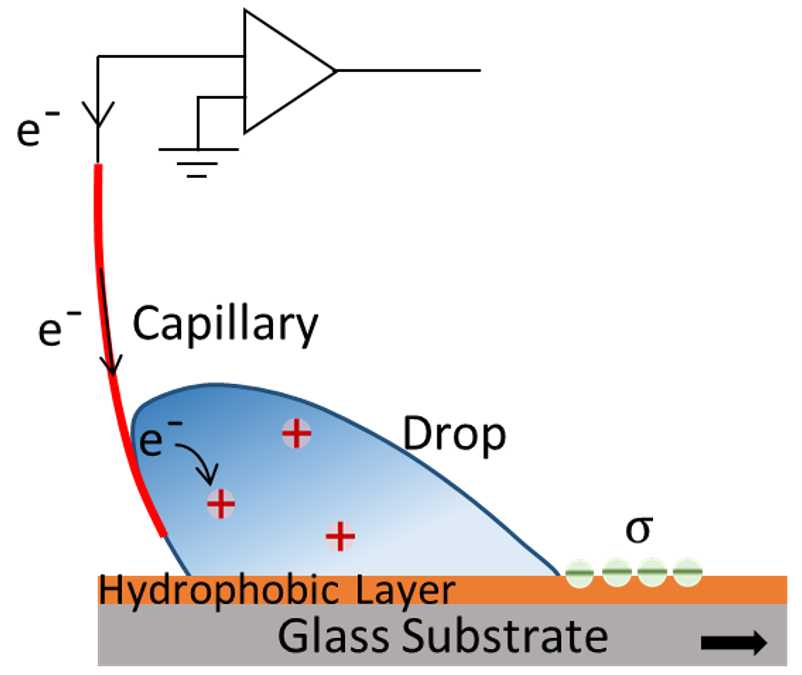 We investigated drop charging at low sliding velocity using an electro drop friction force instrument (eDoFFI). The novelty of eDoFFI is
the simultaneous measurement of the drop discharging current and the friction force acting on the drop. The eDoFFI tool facilitates
control on drop length and width using differently shaped rings. With the Kawasaki-Furmidge friction force equation and our finding we
measure the surface charge density deposited behind the drop.
The reverse sliding of drop along the same scanline facilitates calculation of surface neutralization time constant.
The eDoFFI links two scientific communities: one which focuses on the friction forces and one which focuses on the slide electrification of drops
We investigated drop charging at low sliding velocity using an electro drop friction force instrument (eDoFFI). The novelty of eDoFFI is
the simultaneous measurement of the drop discharging current and the friction force acting on the drop. The eDoFFI tool facilitates
control on drop length and width using differently shaped rings. With the Kawasaki-Furmidge friction force equation and our finding we
measure the surface charge density deposited behind the drop.
The reverse sliding of drop along the same scanline facilitates calculation of surface neutralization time constant.
The eDoFFI links two scientific communities: one which focuses on the friction forces and one which focuses on the slide electrification of drops
Transfer-printing of patterned PEDOT:PSS structures for bendable, stretchable and biodegradable electronics,
Carla Volkert, Renan Colucci, Rüdiger Berger, Pol Besenius, Paul W. M. Blom and Ulrike Kraft✉, J. Mater. Chem. C, 12, 3865 (2024). https://doi.org/10.1039/d3tc04485hPublications in 2023
Kinetic drop friction,
Xiaomei Li, Francisco Bodziony, Mariana Yin, Holger Marschall, Rüdiger Berger, Hans-Jürgen Butt✉, Nature Communications 14, 4571 (2023). https://doi.org/10.1038/s41467-023-40289-8
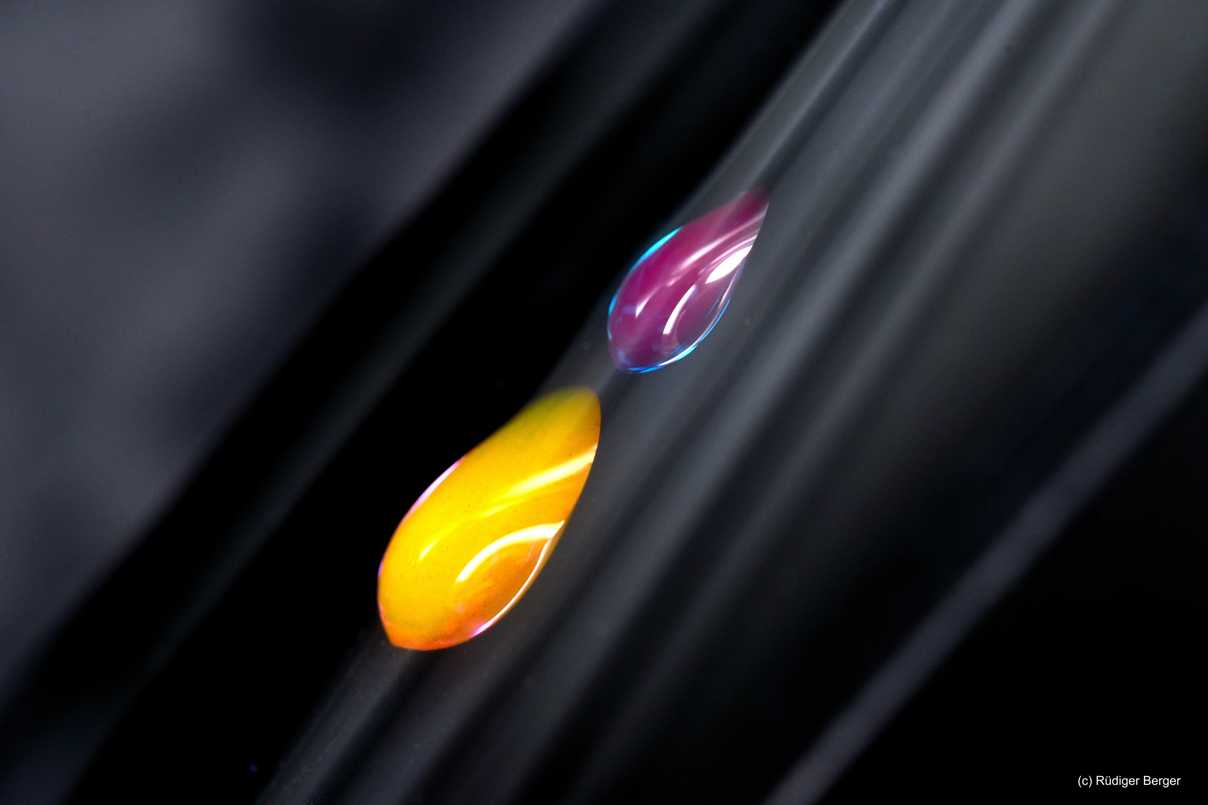 We investigated liquid drops sliding on tilted surfaces. Still, it is impossible to predict the drop's sliding velocity.
We analyzed the velocity, contact width, contact length, advancing and receding contact angle of liquid drops sliding down inclined flat
surfaces made of different materials. We find the friction force acting on sliding drops of polar and non-polar liquids can be
descibed by a dimensionless friction coefficient. This friction coefficient is a material parameter, specific for a liquid/surface combination.
We investigated liquid drops sliding on tilted surfaces. Still, it is impossible to predict the drop's sliding velocity.
We analyzed the velocity, contact width, contact length, advancing and receding contact angle of liquid drops sliding down inclined flat
surfaces made of different materials. We find the friction force acting on sliding drops of polar and non-polar liquids can be
descibed by a dimensionless friction coefficient. This friction coefficient is a material parameter, specific for a liquid/surface combination.
Understanding the evolution of lithium dendrites at Li6.25Al0.25La3Zr2O12 grain boundaries via operando microscopy techniques,
Chao Zhu, Till Fuchs, Stefan A.L. Weber, Felix. H. Richter, Gunnar Glasser, Franjo Weber, Hans-Jürgen Butt, Jürgen Janek✉, Rüdiger Berger✉, Nature Communications 14, 1300 (2023). https://doi.org/10.1038/s41467-023-36792-7
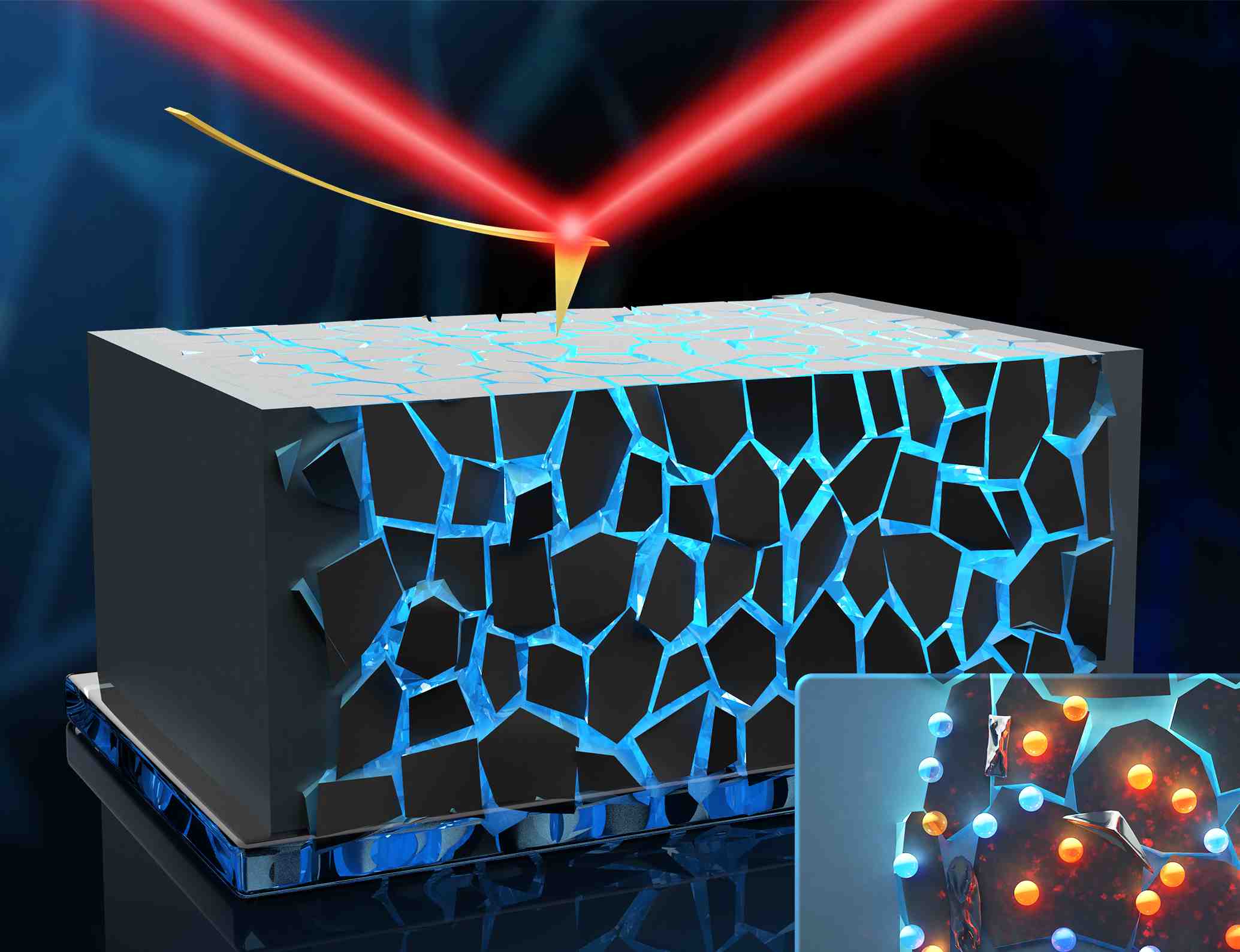 We investigated all-solid-state battery materials while charging an discharging. The growth of lithium dendrites in inorganic solid electrolytes is
an essential drawback that hinders the development of reliable all-solid-state lithium metal batteries. Tpically, all-solid-state batteries suffer from
lithium dendrites which grow beteen anode and cathode and finally lead to a short cut of the battery. Here, we report the use of operando Kelvin
probe force microscopy measurements
to map locally time-dependent electric potential changes in LLZO garnet-type solid electrolyte.
We find that the Galvani potential drops at grain boundaries near the lithium metal electrode during plating as a response to the preferential
accumulation of electrons.
We investigated all-solid-state battery materials while charging an discharging. The growth of lithium dendrites in inorganic solid electrolytes is
an essential drawback that hinders the development of reliable all-solid-state lithium metal batteries. Tpically, all-solid-state batteries suffer from
lithium dendrites which grow beteen anode and cathode and finally lead to a short cut of the battery. Here, we report the use of operando Kelvin
probe force microscopy measurements
to map locally time-dependent electric potential changes in LLZO garnet-type solid electrolyte.
We find that the Galvani potential drops at grain boundaries near the lithium metal electrode during plating as a response to the preferential
accumulation of electrons.
When crystals flow,
Chien-Hua Tu, Martin Steinhart, Rüdiger Berger, Michael Kappl, Hans-Jürgen Butt, George Floudas✉, Science Advances (2023).
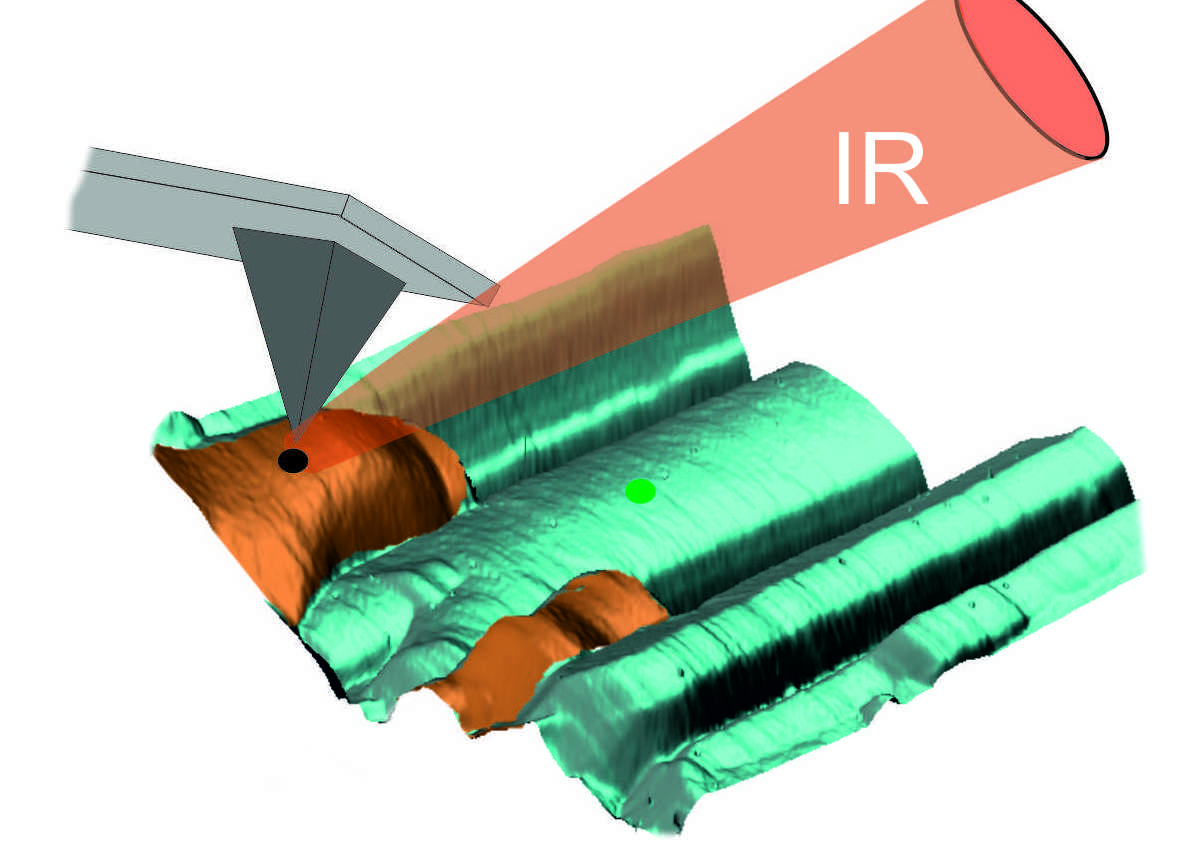 Semicrystalline polymers are solids of very high viscosity that can only flow above their melting temperature. By employing confinement
within nanoscopic cylindrical pores we show that a semicrystalline polymer can flow at temperatures below the melting point with a
viscosity intermediate to the melt and crystal states. IR-AFM was employed to characterize the state of the polymer inside the pores.
Intense adsorption peaks at 1061 cm-1, 1108 cm-1 and 1149 cm-1 demonstrate a semicrystalline state of PEO within the nanopores.
Semicrystalline polymers are solids of very high viscosity that can only flow above their melting temperature. By employing confinement
within nanoscopic cylindrical pores we show that a semicrystalline polymer can flow at temperatures below the melting point with a
viscosity intermediate to the melt and crystal states. IR-AFM was employed to characterize the state of the polymer inside the pores.
Intense adsorption peaks at 1061 cm-1, 1108 cm-1 and 1149 cm-1 demonstrate a semicrystalline state of PEO within the nanopores.
Fast-release kinetics of a pH-responsive polymer detected by dynamic contact angles,
Xiaomei Li, Krisada Auepattana-Aumrung, Hans-Jürgen Butt, Daniel Crespy✉, Rüdiger Berger✉, Chemical Physics Letters 158, 144901 (2023). https://doi.org/10.1063/5.0142928
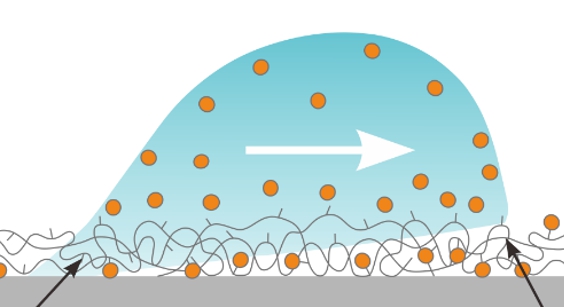 Polymers conjugated with active agents have applications in biomedicine, anticorrosion, and smart agriculture. When the active agent is used
as a drug, corrosion inhibitor, or pesticide it is normally released upon a specific stimulus. The efficiency and the sustainability of active
agents are determined by the released kinetics. In this work, we study the fast-release kinetics of 8-hydroxyquinoline (8HQ) from a pH-responsive
random copolymer of methyl methacrylate and 8-quinolinyl-sulfide-ethyl acrylate (P(MMA-co-HQSEA)) by hydrolysis on the thiopropionate groups.
We used contact angle measurements of sliding drops as an elegant way to characterize release kinetics.
Polymers conjugated with active agents have applications in biomedicine, anticorrosion, and smart agriculture. When the active agent is used
as a drug, corrosion inhibitor, or pesticide it is normally released upon a specific stimulus. The efficiency and the sustainability of active
agents are determined by the released kinetics. In this work, we study the fast-release kinetics of 8-hydroxyquinoline (8HQ) from a pH-responsive
random copolymer of methyl methacrylate and 8-quinolinyl-sulfide-ethyl acrylate (P(MMA-co-HQSEA)) by hydrolysis on the thiopropionate groups.
We used contact angle measurements of sliding drops as an elegant way to characterize release kinetics.
Deep learning to analyze sliding drops,
Sajjad Shumaly, Fahimeh Darvish, Xiaomei Li, Alexander Saal, Chirag Hinduja, Werner Steffen, Oleksandra Kukharenko, Hans-Jürgen Butt, and Rüdiger Berger✉, Langmuir 38, 14635-14643 (2023). https://doi.org/10.1021/acs.langmuir.2c02847
The analysis of videos of drops sliding down a tilted plate is hampered due to the low resolution of the cutout
area. Here we analyze all video images automatically, while the drops are sliding down the tilted plate. To
increase the accuracy of contact angles, we implemnted a 4-segment super-resolution
optimized-fitting (4S-SROF) method. We developed a deep learning-based super-resolution model. Our method
improved the accuracy by 21%
for contact angles lower than 90° and by 33% for contact angles higher than 90°.
left side: please enlarge video for better view.
When audience takes stage: Pseudo-localized-high-concentration electrolyte with lithium nitrate as the only salt enables lithium metal batteries with excellent temperature and cathode adaptability,
Tianle Zheng, Bingyin Zhu, Jianwei Xiong, Tonghui Xu, Chao Zhu, Can Liao, Shanshan Yin, Guangjiu Pan, Yuxin Liang, Xiaotang Shi, Hongbin Zhao, Rüdiger Berger, Ya-Jun Cheng, Yonggao Xia, Peter Müller-Buschbaum✉, Energy Storage Materials 59, 102782 (2023) https://doi.org/10.1016/j.ensm.2023.102782Forced flows in liquid bridges,
Ilia Roisman✉, Mohammad Abboud, Philipp Brockmann, Fiona Berner, Rüdiger Berger, Pauline Rothmann-Brumm, Hans Martin Sauer, Edgar Dörsam, Jeanette Hussong, Current Opinion in Colloid & Interface Science 67, 101738 (2023). https://doi.org/10.1016/j.cocis.2023.101738Molecular transport and water condensation inside mesopores with wettability step gradients,
Laura Despot, Chirag Hinduja, Robert Lehn, Joanna Mikolei, Timo Richter, Kilian Köbschall, Mathias Stanzel, Rüdiger Berger, Jeanette Hussong ✉, Nanoscale Advances 5, 6123-6134 (2023). https://doi.org/10.1039/D3NA00594AFree standing dry and stable nanoporous polymer films made through mechanical deformation,
Hsiao-Ping Hsu, Manjesh K. Singh, Yu Cang, Heloise Therien-Aubin, Markus Mezger, Rüdiger Berger, Ingo Lieberwirth, George Fytas and Kurt Kremer✉, Advanced Science 2207472 (2023). https://doi.org/10.1002/advs.202207472Interface Tweaking of Perovskite Solar Cells with Carbon Nitride-based 2D Materials,
Naveen Harindu Hemasiri, Muhammad Ashraf, Samrana Kazim, Robert Graf, Rüdiger Berger, Nisar Ullah, Muhammad Nawaz Tahir, and Shahzada Ahmad✉, Nano Energy 109, 108326 (2023). https://doi.org/10.1016/j.nanoen.2023.108326Tuning static drop friction,
Alexandre Laroche, Abhinav Naga, Chirag Hinduja, Azadeh Aghili Sharifi, Alexander Saal, Hyeonjin Kim, Nan Gao, Sanghyuk Wooh, Hans-Jürgen Butt, Rüdiger Berger, Doris Vollmer✉, Droplet, (2023). https://doi.org/10.1002/dro2.42Effects of surface morphology changes on FTIR-ATR spectroscopy with compacted Sodium Alanate (NaAlH4) during cycling,
Matthias Enders, Chao Zhu, Maximilian Kleber, Georg Derscheid, Rüdiger Berger, Hans-Dieter Bauer✉, Birgit Scheppat,International Journal of Hydrogen Energy, 48, 709 - 722 (2023). https://doi.org/10.1016/j.ijhydene.2022.10.014
Publications in 2022
Scanning Drop Friction Force Microscopy,
Chirag Hinduja, Alexandre Laroche, Sajjad Shumaly, Yujiao Wang, Doris Vollmer, Hans-Jürgen Butt, and Rüdiger Berger✉,Langmuir 38, 14635-14643 (2022). https://doi.org/10.1021/acs.langmuir.2c02046
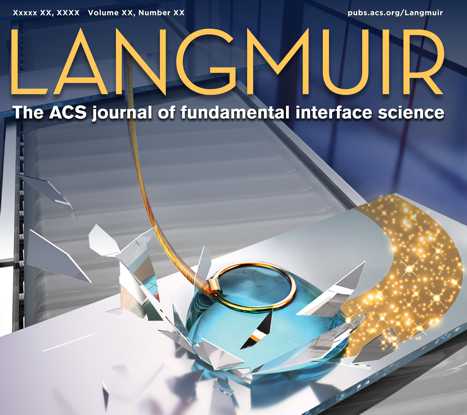 We developped a novel tool which we name scanning drop friction force microscopy (sDoFFI). In sDoFFI, a drop of liquid is raster-scanned over a surface. The friction
force (i.e. lateral adhesion force) acting on the moving contact line is plotted against the drop position. Using sDoFFI, we obtained 2D
wetting maps of the samples having sizes in the order of several square centimeters.
sDoFFI detects features that are smaller than 0.5 µm in size. We quantified the sliding behavior of drops across the boundary
separating areas with different contact angles on the model sample. The sliding of a drop across this transition line follows a
characteristic stick-slip motion. The sDoFFI is a new tool for 2D characterization of wetting
properties, which is applicable to laboratory-based samples but also characterizes biological and commercial surfaces.
We developped a novel tool which we name scanning drop friction force microscopy (sDoFFI). In sDoFFI, a drop of liquid is raster-scanned over a surface. The friction
force (i.e. lateral adhesion force) acting on the moving contact line is plotted against the drop position. Using sDoFFI, we obtained 2D
wetting maps of the samples having sizes in the order of several square centimeters.
sDoFFI detects features that are smaller than 0.5 µm in size. We quantified the sliding behavior of drops across the boundary
separating areas with different contact angles on the model sample. The sliding of a drop across this transition line follows a
characteristic stick-slip motion. The sDoFFI is a new tool for 2D characterization of wetting
properties, which is applicable to laboratory-based samples but also characterizes biological and commercial surfaces.
Nanoscale Capillary Bridges Control the Adhesion of Ice: Implications for Anti-Icing via Hydrophobic Coatings,
Ngoc N. Nguyen✉, Sina Davani, Ramazan Asmatulu, Michael Kappl, Rüdiger Berger✉, Hans-Jürgen Butt,ACS Applied Nano Materials 5, 19017 - 19024 (2022). https://doi.org/10.1021/acsanm.2c04879
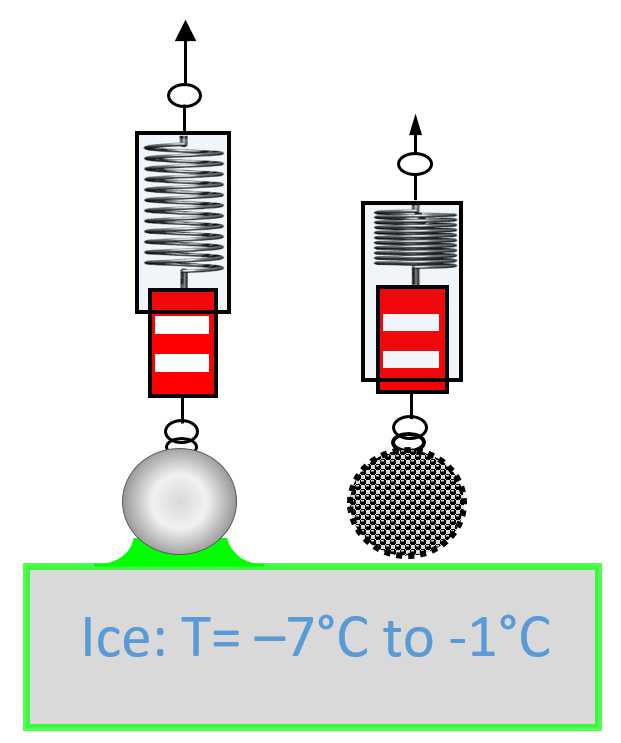 Solids often exhibit low friction on ice. Why does then ice and snow stick to surfaces in winter? Here, we report on
measurements of adhesion forces between an ice surface and a solid sphere. We observed a bell-shaped dependence of the adhesion
force on the temperature. The adhesion forces are surprisingly high in a temperature range between -3 and -0.5 °C.
This temperature dependence of the adhesion force is described solely by the radius of curvature of a capillary bridge forming
between the quasi-liquid layer on ice surface and the sphere.
Solids often exhibit low friction on ice. Why does then ice and snow stick to surfaces in winter? Here, we report on
measurements of adhesion forces between an ice surface and a solid sphere. We observed a bell-shaped dependence of the adhesion
force on the temperature. The adhesion forces are surprisingly high in a temperature range between -3 and -0.5 °C.
This temperature dependence of the adhesion force is described solely by the radius of curvature of a capillary bridge forming
between the quasi-liquid layer on ice surface and the sphere.
Pinning forces of sliding drops at defects,
Alexander Saal, Benedikt B. Straub, Hans Juergen Butt and Rüdiger Berger✉,Europhys. Lett. 139, 47001 (2022). https://doi.org/10.1209/0295-5075/ac7acf
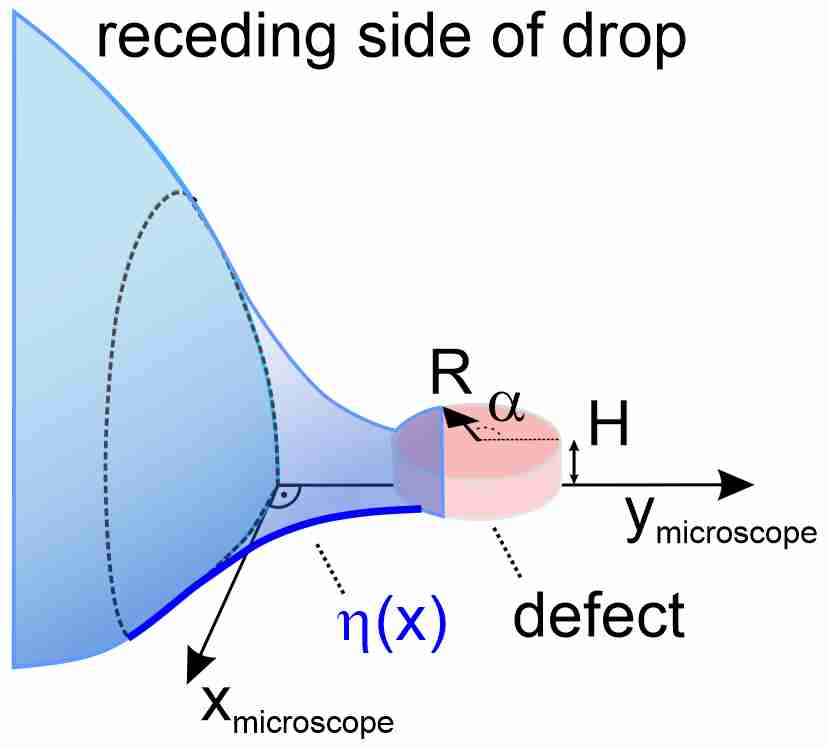 No experimental verification of forces owing to the three phase contact line deformation at single defects is available. We imaged the contact
line of sliding drops on hydrophobic surfaces by video microscopy. From the deformation of the contact line close to a defect, we calculate the
force acting on a sliding drop using an equation going back to Joanny and de Gennes (J. Chem. Phys. 81, 552, 1984). The calculated forces
quantitatively agree with directly measured forces acting between model defects and water drops.
No experimental verification of forces owing to the three phase contact line deformation at single defects is available. We imaged the contact
line of sliding drops on hydrophobic surfaces by video microscopy. From the deformation of the contact line close to a defect, we calculate the
force acting on a sliding drop using an equation going back to Joanny and de Gennes (J. Chem. Phys. 81, 552, 1984). The calculated forces
quantitatively agree with directly measured forces acting between model defects and water drops.
Adaptation and Recovery of a Styrene-Acrylic Acid Copolymer Surface to Water,
Xiaomei Li, Mirela Encheva, Hans-Jürgen Butt, Ellen H.G. Backus✉ and Rüdiger Berger✉,Macromol. Rapid Commun. 43, 2100733 (2022). https://doi.org/10.1002/marc.202100733
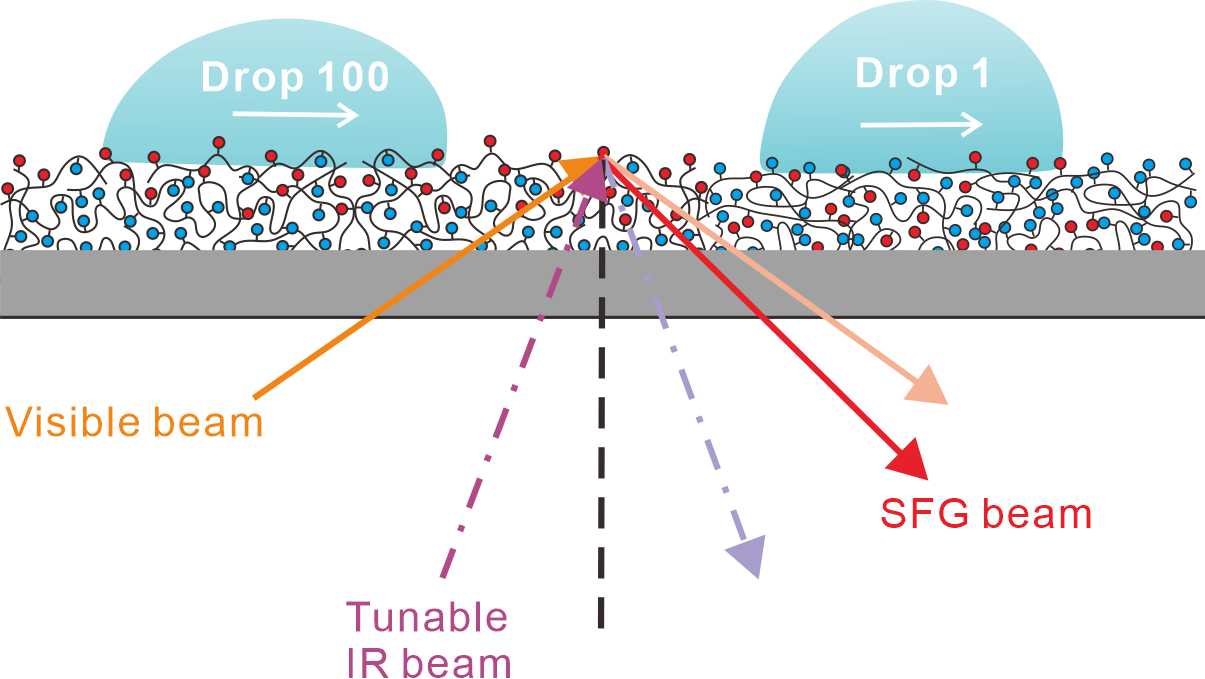 We investigated how drops sliding down an adaptive surface lead to changes of the dynamic contact angles.
We confrimed that two adaptation processes play a role: (i) the adaptation of the surface upon bringing it into contact
to the drop (wetting) and (ii) the adaptation of the surface after the drop passed (dewetting).
We investigated samples made from random styrene (PS)/acrylic acid (PAA) copolymers, which are exposed to water.
Sum-frequency generation spectroscopy (SFG) and tilted-plate measurements indicate that during wetting, the PS segments
displace from the interface, while PAA segments are enriched. This structural adaptation of the PS/PAA random
copolymer to water remains after dewetting. Annealing the adapted polymer induces reorientation of the PS segments to the surface.
We investigated how drops sliding down an adaptive surface lead to changes of the dynamic contact angles.
We confrimed that two adaptation processes play a role: (i) the adaptation of the surface upon bringing it into contact
to the drop (wetting) and (ii) the adaptation of the surface after the drop passed (dewetting).
We investigated samples made from random styrene (PS)/acrylic acid (PAA) copolymers, which are exposed to water.
Sum-frequency generation spectroscopy (SFG) and tilted-plate measurements indicate that during wetting, the PS segments
displace from the interface, while PAA segments are enriched. This structural adaptation of the PS/PAA random
copolymer to water remains after dewetting. Annealing the adapted polymer induces reorientation of the PS segments to the surface.
Spontaneous charging affects the motion of sliding drops,
Xiaomei Li, Pravash Bista, Amy Z. Stetten, Henning Bonart, Maximilian T. Schür, Steffen Hardt, Francisco Bodziony, Holger Marschall, Alexander Saal, Xu Deng, Rüdiger Berger, Stefan A.L. Weber✉ and Hans-Jürgen Butt✉,Nature Physics 18, 713 - 719 (2022). https://doi.org/10.1038/s41567-022-01563-6
 Here we demonstrate that viscous dissipation and activated dynamics cannot fully explain the complex paths of sliding or impacting drops.
To accurately determine the forces experienced by moving drops, we imaged their trajectory when sliding down a tilted surface.
We found that drop motion on low-permittivity substrates is substantially influenced by electrostatic forces. Our findings confirm that
electrostatics must be taken into consideration for the description of the motion of water, aqueous electrolytes and ethylene glycol on
hydrophobic surfaces. Our results are relevant for improving the control of drop motion in many applications, including printing, microfluidics,
water management and triboelectric nanogenerators.
Here we demonstrate that viscous dissipation and activated dynamics cannot fully explain the complex paths of sliding or impacting drops.
To accurately determine the forces experienced by moving drops, we imaged their trajectory when sliding down a tilted surface.
We found that drop motion on low-permittivity substrates is substantially influenced by electrostatic forces. Our findings confirm that
electrostatics must be taken into consideration for the description of the motion of water, aqueous electrolytes and ethylene glycol on
hydrophobic surfaces. Our results are relevant for improving the control of drop motion in many applications, including printing, microfluidics,
water management and triboelectric nanogenerators.
Review: Contact angle hysteresis,
Hans-Jürgen Butt✉, Jie Liu, Kaloian Koynov, Benedikt Straub, Chirag Hinduja, Ilia Roismann, Rüdiger Berger, Xiaomei Li, Doris Vollmer, Werner Steffen, Michael Kappl,Current Opinion in Colloid and Interface Science (2022). https://doi.org/10.1016/j.cocis.2022.101574
Acidic pH Promotes Refolding and Macroscopic Assembly of Amyloid Peptides at the Air-Water Interface,
Hao Lu✉, Luca Bellucci, Shumei Sun, Daizong Qi, Marta Rosa, Rüdiger Berger, Stefano Corni, and Mischa Bonn✉,J. Phys. Chem. Lett. (2022). doi.org/10.1021/acs.jpclett.2c01171
Publications in 2021
Clathrate Adhesion Induced by Quasi-Liquid Layer,
Ngoc N. Nguyen✉, Rüdiger Berger✉, Michael Kappl, Hans-Jürgen Butt,Journal of Physical Chemistry C 125, 21293 - 21300 (2021). https://doi.org/10.1021/acs.jpcc.1c06997
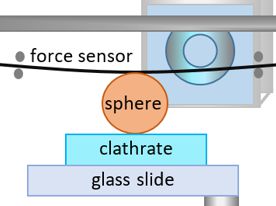 The adhesive force of clathrates to surfaces is a century-old problem of pipeline blockage
for the energy industry. Here, we provide new physical insight into the origin of this force
by accounting for the existence of a quasi-liquid layer (QLL) on clathrate surfaces. To gain
this insight, we measure the adhesive force between a tetrahydrofuran clathrate and a solid
sphere. We detect a strong adhesion, which originates from a capillary bridge that is formed
from a nanometer-thick QLL on the clathrate surface. The curvature of this capillary bridge is
nanoscaled, causes a large negative Laplace pressure, and leads to a strong capillary attraction.
The adhesive force of clathrates to surfaces is a century-old problem of pipeline blockage
for the energy industry. Here, we provide new physical insight into the origin of this force
by accounting for the existence of a quasi-liquid layer (QLL) on clathrate surfaces. To gain
this insight, we measure the adhesive force between a tetrahydrofuran clathrate and a solid
sphere. We detect a strong adhesion, which originates from a capillary bridge that is formed
from a nanometer-thick QLL on the clathrate surface. The curvature of this capillary bridge is
nanoscaled, causes a large negative Laplace pressure, and leads to a strong capillary attraction.
"Liquid-like" Water in Clathrates Induced by Host-Guest Hydrogen,
Ngoc N. Nguyen✉, Rüdiger Berger✉, Manfred Wagner, Jürgen Thiel, Hans-Jürgen Butt, Rober Graf✉,Journal of Physical Chemistry C 125, 15751-15757 (2021). https://DOI: 10.1021/acs.jpcc.1c05531
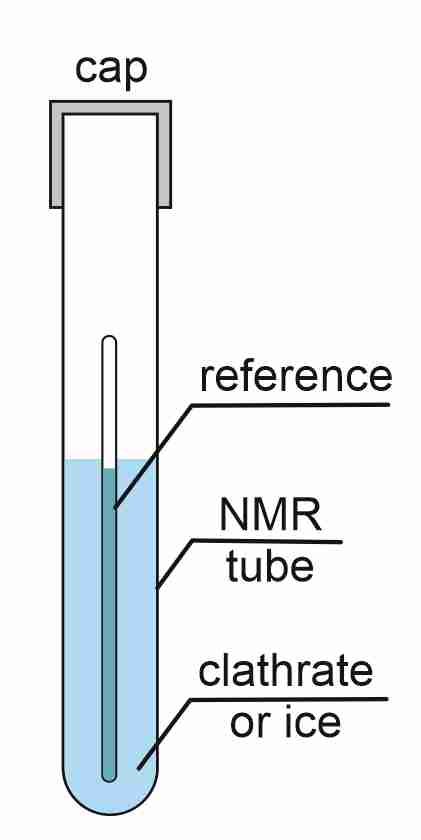 In this contribution we discuss the stability of clathrate structures. Clathrates are water molecules which form a host lattice structure
and encapsulates guest molecules. Up to now, all water molecules in the host lattice are considered ice-like crystallized. Here,
we discovered the occurrence of "liquid-like" water molecules and the resulting defects in (polar) tetrahydrofuran clathrates by
liquid-state 1H-NMR experiments.
In this contribution we discuss the stability of clathrate structures. Clathrates are water molecules which form a host lattice structure
and encapsulates guest molecules. Up to now, all water molecules in the host lattice are considered ice-like crystallized. Here,
we discovered the occurrence of "liquid-like" water molecules and the resulting defects in (polar) tetrahydrofuran clathrates by
liquid-state 1H-NMR experiments.
Revisiting Solvent Additives for the Fabrication of Polymer: Fullerene Solar Cells: Exploring a Series of Benzaldehydes,
C. Sprau, J. Kattenbusch, Y. Li, E. Müller, D. Gerthsen, R. Berger, J. J. Michels, A. Colsmann✉,Solar Rapid Research Letters 5, 2100238 (2021). https://doi.org/10.1002/solr.202100238
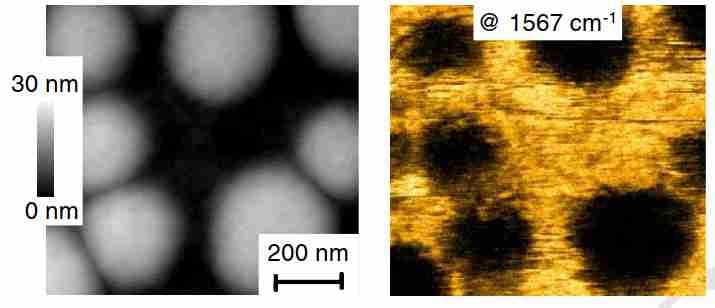 The power conversion effciencies of organic solar cells delicately depend on the morphology of the light-harvesting
bulk heterojunctions. Upon deposition from solution, the formation of tailored bicontinuous networks
of polymers and fullerenes is often achieved using combinations of solvents and solvent additives. In order to
differentiate material phases by molecular fingerprints, we used a novel combination of infrared (IR) absorption
spectroscopy (nano-IR).
The power conversion effciencies of organic solar cells delicately depend on the morphology of the light-harvesting
bulk heterojunctions. Upon deposition from solution, the formation of tailored bicontinuous networks
of polymers and fullerenes is often achieved using combinations of solvents and solvent additives. In order to
differentiate material phases by molecular fingerprints, we used a novel combination of infrared (IR) absorption
spectroscopy (nano-IR).
Adaptation of a styrene-acrylic acid copolymer surface to water,
Xiaomei Li, Simon Silge, Alexander Saal, Gunnar Kircher, Kaloian Koynov, Rüdiger Berger✉, Hans-Jürgen Butt,Langmuir 37, 1571-1577 (2021). https://doi.org/10.1021/acs.langmuir.0c03226
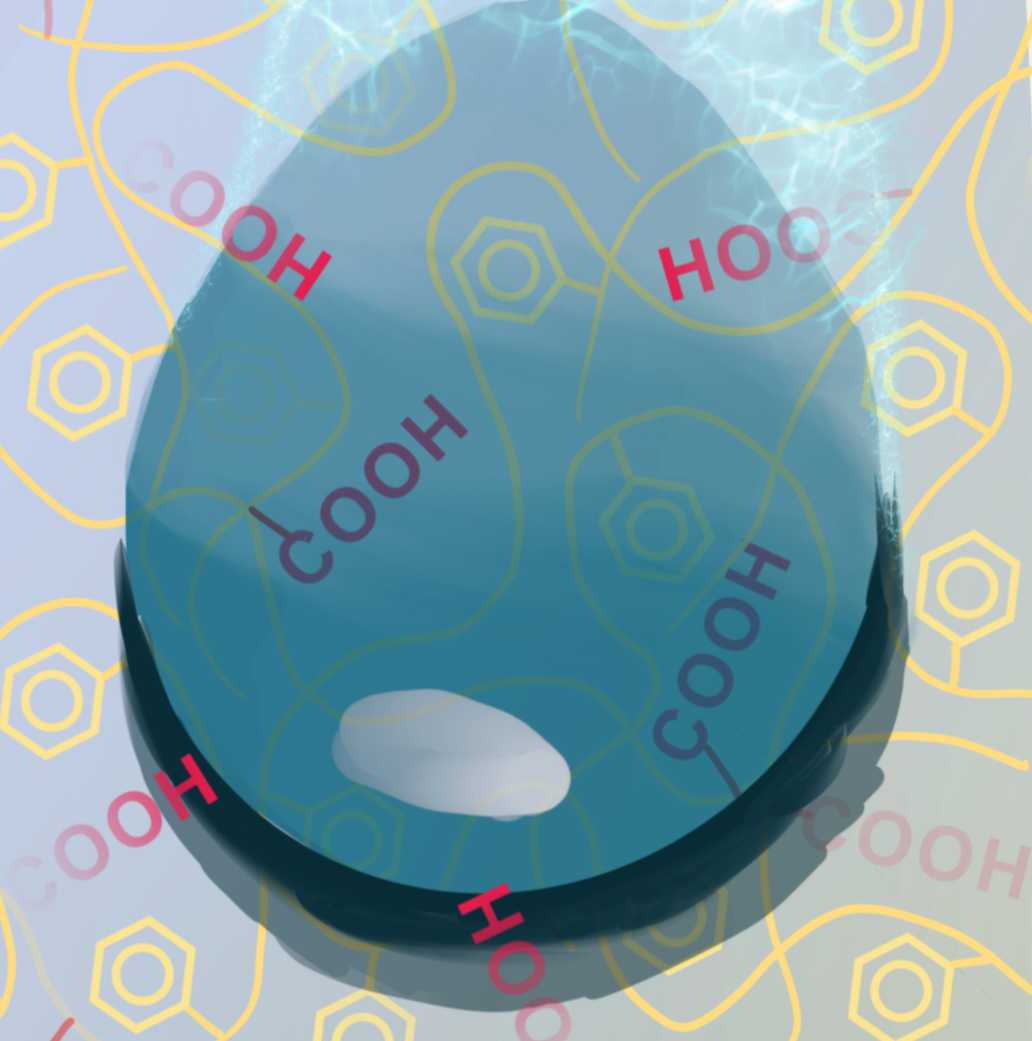 Solid surfaces, in particular polymer surfaces, are able to adapt upon contact with a liquid. Adaptation results
in an increase in contact angle hysteresis and influences the mobility of sliding drops on surfaces. To study
adaptation and its kinetics, we investigated a random copolymer composed of styrene and acrylic acid (PS/PAA).
By applying the latest adaptation theory (Butt et al. Langmuir 2018, 34, 11292), we estimated the time constant
of this adaptation process to be significant smaller than 1 s.
Solid surfaces, in particular polymer surfaces, are able to adapt upon contact with a liquid. Adaptation results
in an increase in contact angle hysteresis and influences the mobility of sliding drops on surfaces. To study
adaptation and its kinetics, we investigated a random copolymer composed of styrene and acrylic acid (PS/PAA).
By applying the latest adaptation theory (Butt et al. Langmuir 2018, 34, 11292), we estimated the time constant
of this adaptation process to be significant smaller than 1 s.
Treffen sich drei Phasen...
Hans-Jürgen Butt und Rüdiger Berger,Physik Journal 20 Nr. 4, 29-34 (2021). Physik Journal Ausgabe April 2021
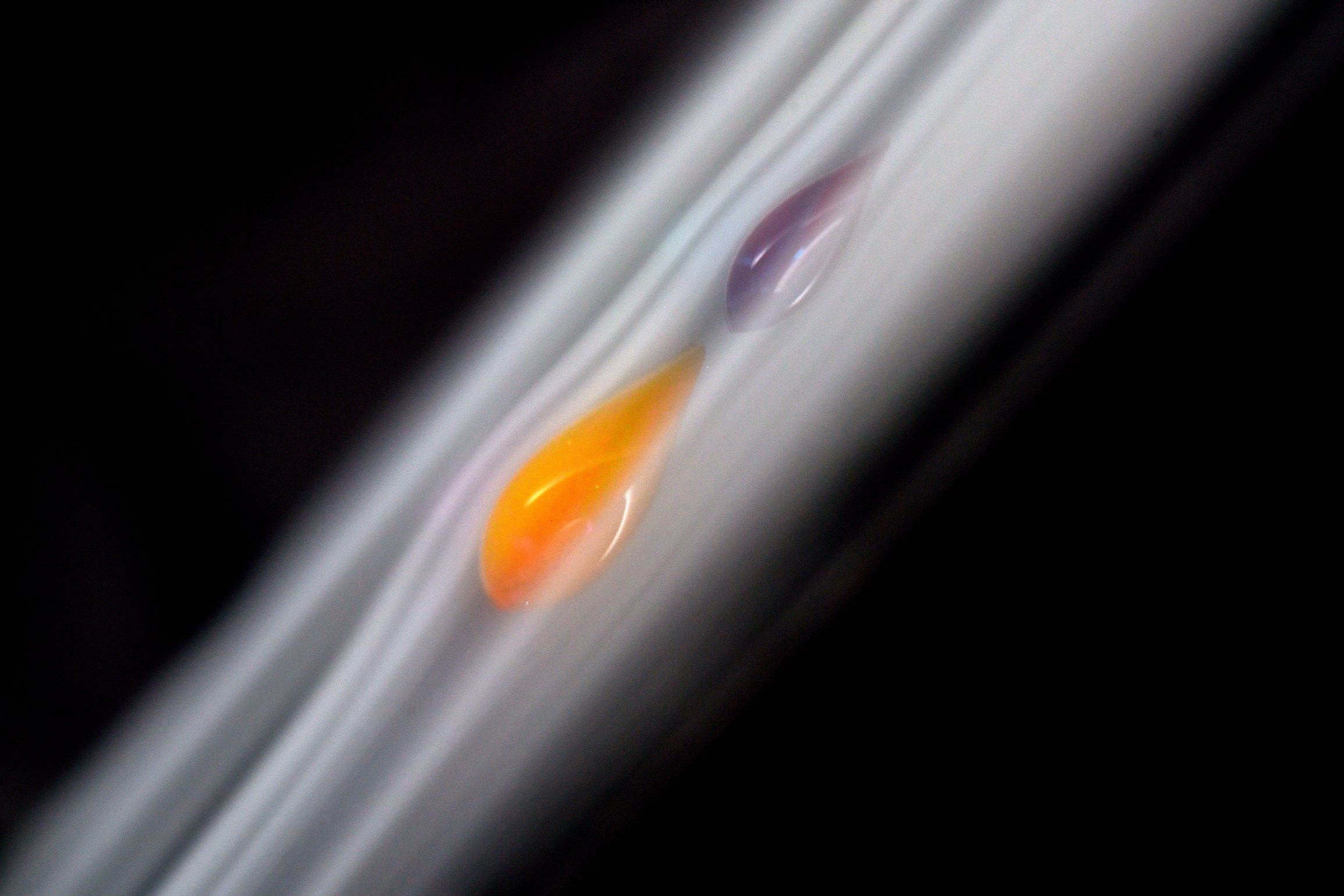 In diesem Beitrag wenden wir uns an Physikinteressierte aus allen Bereichen der akademischen Forschung, Wirtschaft und Lehre.
In den letzten 200 Jahren ist es gelungen, wesentliche Aspekte von Benetzungsphänomenen im Gleichgewicht zu verstehen und
damit die Benetzung in vielen Fällen zu kontrollieren. Aber es liegt in weiter Ferne, dynamische Benetzung qualitativ zu
verstehen oder sogar quantitativ vorherzusagen. Um beispielsweise die Bewegung eines Tropfens auf einer schiefen Ebene
zu beschreiben, sind immer noch mehrere ad-hoc-Parameter notwendig. Es ist nicht geklärt, wie es zur Kontaktwinkelhysterese
kommt und wie sich diese kontrollieren und vorhersagen lässt. Wir beschreiben den Stand der Forschung der dynamischen Benetzung. Um diese besser zu verstehen ist es notwendig, die Physik
nahe der Kontaktlinie, an der Flüssigkeit, Festkörper und Gas aufeinandertreffen, zu betrachten.
In diesem Beitrag wenden wir uns an Physikinteressierte aus allen Bereichen der akademischen Forschung, Wirtschaft und Lehre.
In den letzten 200 Jahren ist es gelungen, wesentliche Aspekte von Benetzungsphänomenen im Gleichgewicht zu verstehen und
damit die Benetzung in vielen Fällen zu kontrollieren. Aber es liegt in weiter Ferne, dynamische Benetzung qualitativ zu
verstehen oder sogar quantitativ vorherzusagen. Um beispielsweise die Bewegung eines Tropfens auf einer schiefen Ebene
zu beschreiben, sind immer noch mehrere ad-hoc-Parameter notwendig. Es ist nicht geklärt, wie es zur Kontaktwinkelhysterese
kommt und wie sich diese kontrollieren und vorhersagen lässt. Wir beschreiben den Stand der Forschung der dynamischen Benetzung. Um diese besser zu verstehen ist es notwendig, die Physik
nahe der Kontaktlinie, an der Flüssigkeit, Festkörper und Gas aufeinandertreffen, zu betrachten.
Electrospun nanocomposite fibers from lignin and iron oxide as supercapacitor material,
Pichitchai Butnoi, Autchara Pangon, Rüdiger Berger, Hans-Jürgen Butt, Varol Intasanta✉,Journal of Materials Research and Technology 12, 2153-2167 (2021). https://doi.org/10.1016/j.jmrt.2021.04.017
Control of Electronic Properties of Functional Organic and Inorganic Materials Through Nano-Confinement,
Jongkuk Ko, Rüdiger Berger, Hyemin Lee, Hyunsik Yoon✉, Jinhan Cho✉, and Kookheon Char,Chem. Soc. Review 50, 3585-3628 (2021). https://doi.org/10.1039/D0CS01501F
Stable Lignin-Rich Nanofibers for Binder-Free Carbon Electrodes in Supercapacitors,
Phakkhanan Khamnantha, Chanakran Homla-or, Khomson Suttisintong, Jedsada Manyam, Marisa Raita, Verawat Champreda, Varol Intasanta, Hans-Jürgen Butt, Rüdiger Berger, and Autchara Pangon✉,ACS Applied Nano Materials 4, 13099-13111 (2021). https://doi.org/10.1021/acsanm.1c02637
Publications in 2020
When and how self-cleaning of superhydrophobic surfaces works,
Florian Geyer, Maria D'Acunzi, Azadeh Sharifi, Alexander Saal, Nan Gao, Anke Kaltbeitzel, Tim-Frederik Sloot, Rüdiger Berger, Hans-Jürgen Butt✉, Doris Vollmer✉, Science Advances 6, eaaw9727 (2020). doi: 10.1126/sciadv.aaw9727
We clarify how contamintations are removed from surfaces by sliding drops. We monitored the removal of individual contaminant
particles on the micron scale by confocal microscopy. We correlate this space- and time-resolved information with
measurements of the lateral friction force of the sliding drop. Hydrophilic and hydrophobic particles hardly
influence superhydrophobicity provided that the particle size
exceeds the pore size, or the thickness of the contamination falls below the height of the protrusions.
These detailed insights into self-cleaning allow the rational design of superhydrophobic surfaces that resist contamination
as demonstrated by outdoor environmental and industrial standardized contamination experiments.
⬅ The movie shows a friction force measurement of a sliding drop over a contaminated surface.
Enhanced Vertical Charge Transport of Homo- and Blended Semiconducting Polymers by Nanoconfinement,
Jongkuk Ko, Youngkeol Kim, Jin Soo Kang, Rüdiger Berger✉, Hyunsik Yoon✉, and Kookheon Char✉, Advanced Materials 1908087 (2020). doi: 10.1002/adma.201908087
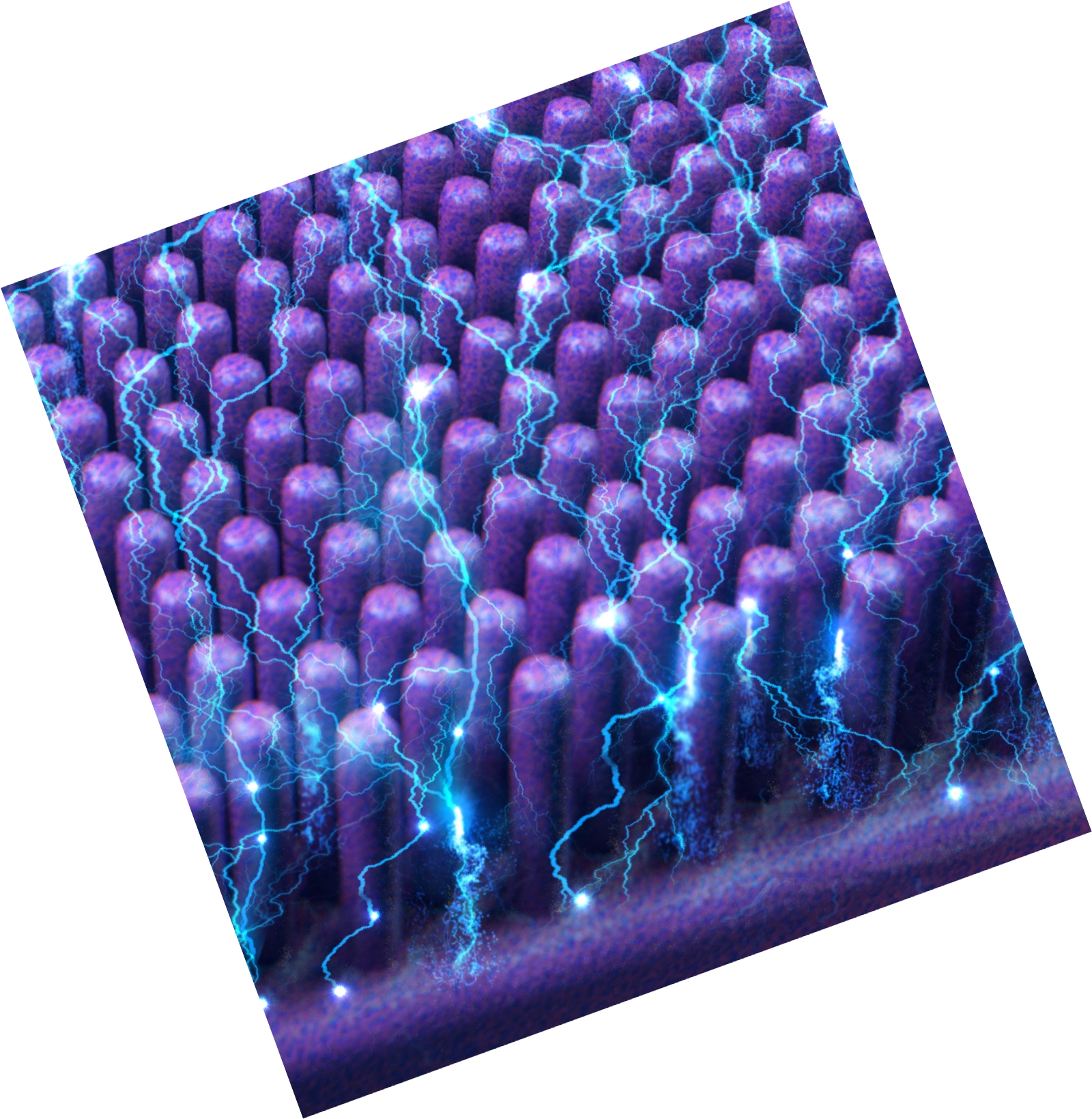 Here we employed the self-assembly of homo- and blended conjugated polymers in confined in nanostructures.
The resulting structures lead to high charge mobility along vertical direction for both homo- and blended conjugated polymers.
Both semicrystalline and amorphous polymers show highly increased population of face-on crystallite despite intrinsic
crystallinity of polymers. They result in more than two orders of magnitude enhanced charge mobility along vertical direction revealed
by nanoscale conductive scanning force microscopy and macroscale IV characteristic measurements.
Here we employed the self-assembly of homo- and blended conjugated polymers in confined in nanostructures.
The resulting structures lead to high charge mobility along vertical direction for both homo- and blended conjugated polymers.
Both semicrystalline and amorphous polymers show highly increased population of face-on crystallite despite intrinsic
crystallinity of polymers. They result in more than two orders of magnitude enhanced charge mobility along vertical direction revealed
by nanoscale conductive scanning force microscopy and macroscale IV characteristic measurements.
Shuffling gait motion of an aerodynamically driven wall-bound drop,
Alexander Saal, Patrick M. Seiler, Daniel Rettenmaier, Michael Ade, Ilia V. Roisman✉, Rüdiger Berger, Hans-Jürgen Butt, and Cameron Tropea,Phys. Rev. Fluids 5, 094006 (2021). https://doi.org/10.1103/PhysRevFluids.5.094006
Hygroscopic Properties of NaCl Nanoparticles on the Surface: A Scanning Force Microscopy Study,
Xiaoxiang Wang, Haozhi Lei, Rüdiger Berger✉, Yi Zhang, Hang Su, Yafang Cheng✉, Phys. Chem. Chem. Phys., 22, 9967 - 9973 (2020). doi: 10.1039/D0CP00155DAdaptive Wetting of Polydimethylsiloxane,
William S.Y. Wong, Lukas Hauer, Abhinav Naga, Anke Kaltbeitzel, Philipp Baumli, Rüdiger Berger, Maria D‘Acunzi, Doris Vollmer, and Hans-Jürgen Butt✉, Langmuir, 36, 7236 - 7245 (2020). doi: 10.1021/acs.langmuir.0c00538Vitamin C loaded polyethylene - synthesis and properties of precise polyethylene with vitamin C defects via acyclic diene metathesis polycondensation,
Oksana Suraev, Carole Champanha, Frederik R. Wurm, Henning Weiss, Rüdiger Berger, Markus Mezger, Katharina Landfester, Ingo Lieberwirth✉, Macromolecules, 53, 2932 - 2941 (2020). https://doi.org/10.1021/acs.macromol.0c00086Entangled Azobenzene-Containing Polymers with Photoinduced Reversible Solid-to-Liquid Transitions for Healable and Reprocessable Photoactuators,
Mingsen Chen, Bingjian Yao, Michael Kappl, Senyang Liu, Jinying Yuan, Rüdiger Berger, Faai Zhang✉, Hans-Jürgen Butt, Yuanli Liu, Si Wu✉, Advanced Functional Materials, 30, 1906752 (2020). doi: 10.1002/adfm.201906752Premelting-Induced Agglomeration of Hydrates: Theoretical Analysis and Modelling,
Ngoc Nguyen✉, Rüdiger Berger, Hans-Jürgen Butt✉, ACS Appl. Mater. Interfaces, 12, 14599 - 14606 (2020). https://doi.org/10.1021/acsami.0c00636Publications in 2019
Book Review:
Berger, R. (2019). Kelvin Probe Force Microscopy: From Single Charge Detection to Device Characterization, Second Volume Sascha Sadewasser and Thilo Glatzel (Eds.), Springer Series in Surface Sciences, Book 65, 2018, 521 pp. ISBN: 9783319756868. Microscopy and Microanalysis, 25(6), 1509-1510. doi:10.1017/S1431927619015083, Microscopy and Microanalysis 25(6), 1509-1510 (2019). doi:10.1017/S1431927619015083
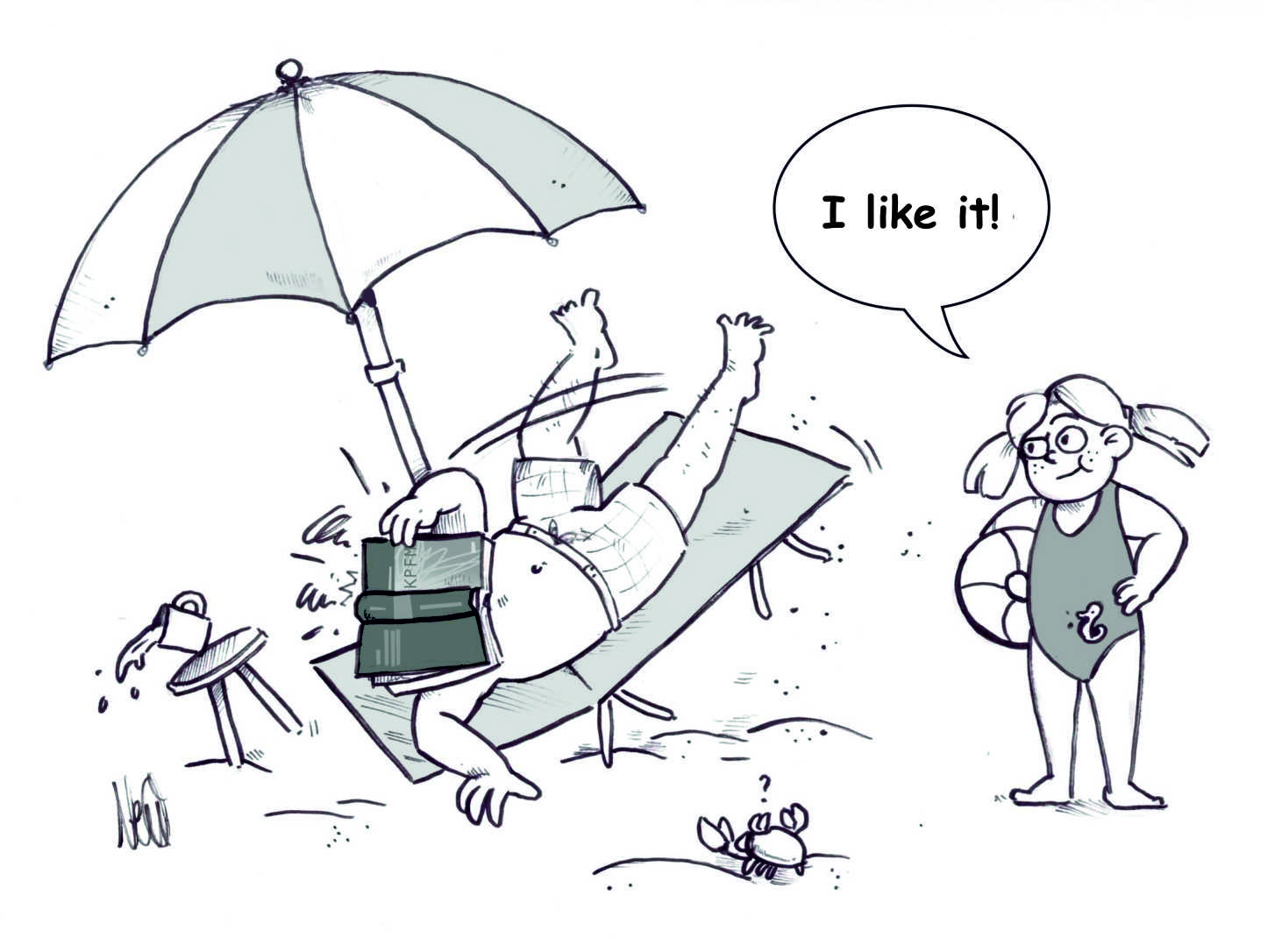 When you hold this 1 kg heavy book in your hand you may say: "It is so thick and heavy, is it worth the effort of carrying the book home and reading it? Why bother?
After all, this is only a book describing Kelvin probe force microscopy. Yet another mode from the plethora
of modes that are known for scanning force microscopy. No one should care!"
When you hold this 1 kg heavy book in your hand you may say: "It is so thick and heavy, is it worth the effort of carrying the book home and reading it? Why bother?
After all, this is only a book describing Kelvin probe force microscopy. Yet another mode from the plethora
of modes that are known for scanning force microscopy. No one should care!"
My daughter liked it and I like the book.
⬅ thanks to Katharina Maisenbacher (MPI-P) for the drawing. I like it!
Surface Pre-melting and Interfacial Interactions of Clathrate Hydrate,
Ngoc N. Nguyen✉, Rüdiger Berger, Hans-Jürgen Butt✉, J. Phys. Chem. C 123, 39, 24080 - 24086 (2019). doi: 10.1021/acs.jpcc.9b06376
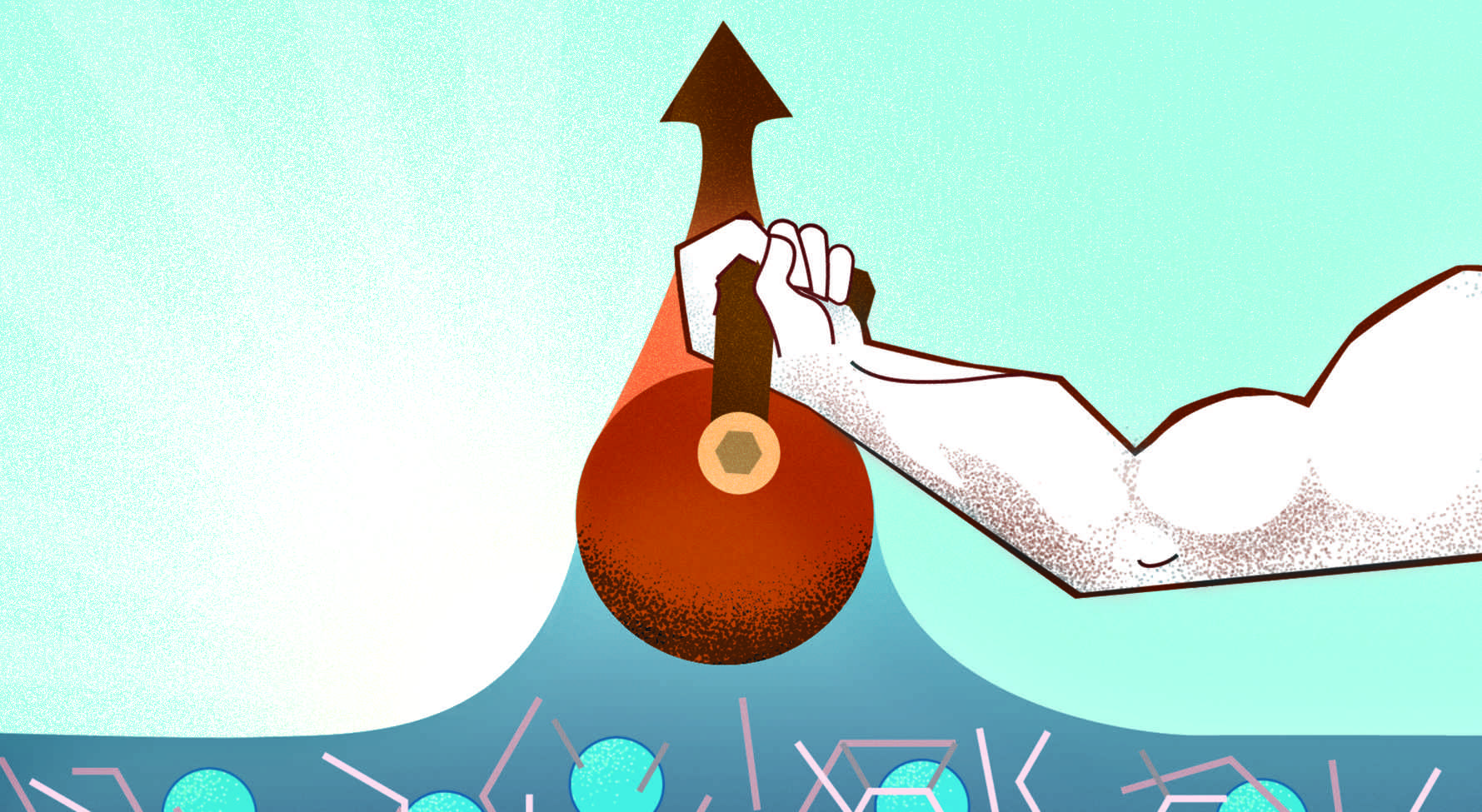 We measured the forces between a semi-clathrate hydrate formed by tetrabutyl ammonium bromide and a silica microsphere
in air and in undecane. Significantly, the analyses of jump-in (attractive) and pull-off (adhesive) forces in
force-distance curves indicate the presence of a quasi-liquid layer (QLL) on the hydrate surface resulting from
interfacial premelting. We have shown that interfacial forces between the sphere and the hydrate surface are dominated
by the capillary formation between the QLL and the sphere. The thickness of the QLL on the hydrate surface is around 11 nm
at -4 °C.
We measured the forces between a semi-clathrate hydrate formed by tetrabutyl ammonium bromide and a silica microsphere
in air and in undecane. Significantly, the analyses of jump-in (attractive) and pull-off (adhesive) forces in
force-distance curves indicate the presence of a quasi-liquid layer (QLL) on the hydrate surface resulting from
interfacial premelting. We have shown that interfacial forces between the sphere and the hydrate surface are dominated
by the capillary formation between the QLL and the sphere. The thickness of the QLL on the hydrate surface is around 11 nm
at -4 °C.
Two-Stage Collapse of PNIPAM Brushes: Viscoelastic Changes Revealed by an Interferometric Laser Technique,
David van Duinen, Hans-Jürgen Butt, and Rüdiger Berger✉, Langmuir 35, 15776 - 15783 (2019). doi: 10.1021/acs.langmuir.9b03205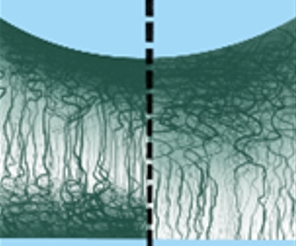 We studied the viscoelastic changes of a poly(N-isopropylacryamide) (PNIPAM) brush layers (51 ± 3 nm thick) with an interferometric laser
method at different temperatures. With this method we were able to investigate the two-stage collapse of beads coated with a
polymer brush layer. The change of the Brownian motion spectrum with temperature indicates two transitions of the PNIPAM brush
layer, one at 36 °C and one at 46 °C. We attribute the first transition to the LCST volume collapse of PNIPAM. The second
transition is dominated by a stiffening of the brush layer.
We studied the viscoelastic changes of a poly(N-isopropylacryamide) (PNIPAM) brush layers (51 ± 3 nm thick) with an interferometric laser
method at different temperatures. With this method we were able to investigate the two-stage collapse of beads coated with a
polymer brush layer. The change of the Brownian motion spectrum with temperature indicates two transitions of the PNIPAM brush
layer, one at 36 °C and one at 46 °C. We attribute the first transition to the LCST volume collapse of PNIPAM. The second
transition is dominated by a stiffening of the brush layer.
Critical analysis of Micro-Thermogravimetry of CuSO4 · 5H2O crystals using heatable Microcantilevers,
Nikhilendu Tiwary, Marjan Zakerin, Filipe Natalio, Eugen Biegler, Fritzsche Marco, Hermann Kaubitzsch, Apurba Laha, Rüdiger Berger✉, V. Ramgopal Rao✉, Journal of Micromechanics and Microengineering 29, 105009 (2019). doi:10.1088/1361-6439/ab30a3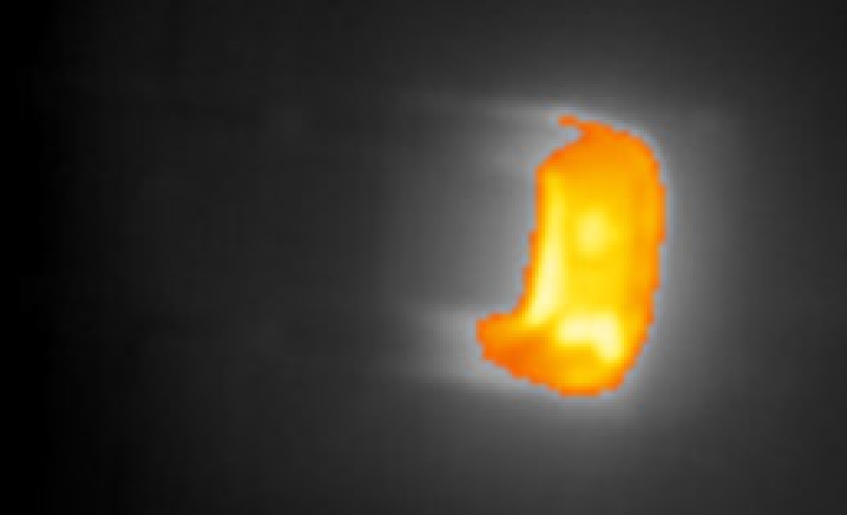 We have critically analysed Micro/nano thermogravimetry (TG) method.
In cooperation with the Indian Institute of Technology we have designed and fabricated a microelectromechanical
thermogravimetric device (MMTG) with integrated microheaters and temperature sensors. The final mass
loss ratio corresponds to the theoretically expected value, although the obtained TG curve deviated
from the standard TG curve of CuSO4 · 5H2O crystals obtained from commercial TG
instruments. We attributed the deviation to the inherent temperature non-uniformity, non-isothermal conditions and
temperature gradients of metallicwire based microheaters.
We have critically analysed Micro/nano thermogravimetry (TG) method.
In cooperation with the Indian Institute of Technology we have designed and fabricated a microelectromechanical
thermogravimetric device (MMTG) with integrated microheaters and temperature sensors. The final mass
loss ratio corresponds to the theoretically expected value, although the obtained TG curve deviated
from the standard TG curve of CuSO4 · 5H2O crystals obtained from commercial TG
instruments. We attributed the deviation to the inherent temperature non-uniformity, non-isothermal conditions and
temperature gradients of metallicwire based microheaters.
⬅ The image shows a red glowing microelectromechanical thermogravimetric device.
Removal of Surface Oxygen Vacancies increases Conductance through TiO2 Thin Films for Perovskite Solar Cells
Alexander Klasen, Phillip Baumli, Qu Sheng, Ewald Johannes, Simon A. Bretschneider, Ilka M. Hermes, Victor W. Bergmann, Christopher Gort, Amilie Axt, Stefan A.L. Weber, Heejae Kim, Hans-Jürgen Butt, Wolfgang Tremel, Rüdiger Berger✉,Journal of Physical Chemistry 123, 22, 13458 - 13466 (2019). doi:10.1021/acs.jpcc.9b02371
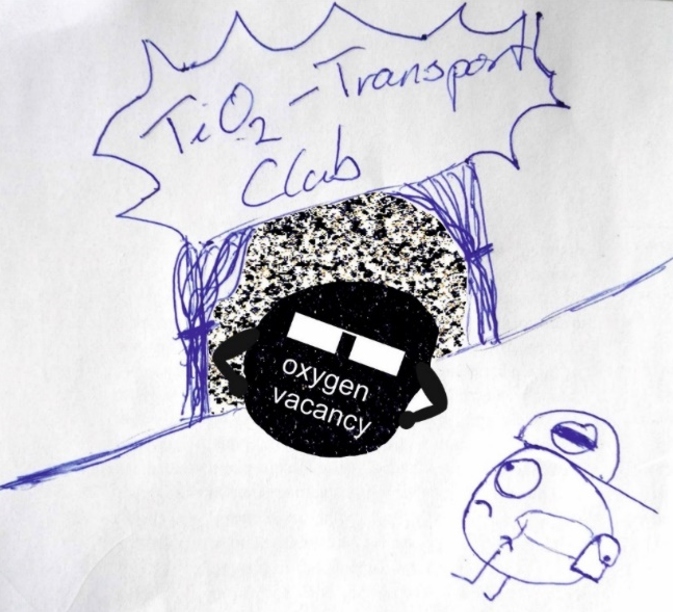 We report that UV-ozone treatment of TiO2 anatase thin films is an efficient method to increase the
conductance through the film by more than one order of magnitude. The increase in conductance is quantified via conductive
scanning force microscopy on freshly annealed and UV-ozone treated TiO2 anatase thin films on fluorine-doped
tin oxide substrates. The increased conductance of TiO2 anatase thin films results in a 2 % increase
of the average power conversion efficiency (PCE) of methylammonium lead iodide based perovskite solar cells.
PCE values up to 19.5 % for mesoporous solar cells are realized. The additional UV-ozone treatment results in a
reduced number of oxygen vacancies at the surface, inferred from X-ray photoelectron spectroscopy (XPS). These
oxygen vacancies at the surface act as charge carrier traps and hinder charge extraction from the adjacent material.
We report that UV-ozone treatment of TiO2 anatase thin films is an efficient method to increase the
conductance through the film by more than one order of magnitude. The increase in conductance is quantified via conductive
scanning force microscopy on freshly annealed and UV-ozone treated TiO2 anatase thin films on fluorine-doped
tin oxide substrates. The increased conductance of TiO2 anatase thin films results in a 2 % increase
of the average power conversion efficiency (PCE) of methylammonium lead iodide based perovskite solar cells.
PCE values up to 19.5 % for mesoporous solar cells are realized. The additional UV-ozone treatment results in a
reduced number of oxygen vacancies at the surface, inferred from X-ray photoelectron spectroscopy (XPS). These
oxygen vacancies at the surface act as charge carrier traps and hinder charge extraction from the adjacent material.
Wie sich Tropfen bewegen
Florian Geyer, Patrick M. Seiler, Doris Vollmer, Rüdiger Berger✉,Physik in Unserer Zeit 2, 90-96 (2019).
 In diesem Beitrag wenden wir uns an Physikinteressierte aus allen Bereichen der akademischen Forschung, Wirtschaft und Lehre.
Wir beschreiben, wie Reibung zwischen einem Flüssigkeitstropfen und einer festen Oberfläche gemessen und berechnet werden kann. Im
Rahmen des Sonderforschungsbereichs 1194 Wechselseitige Beeinflussung
von Transport- und Benetzungsvorgängen erläutern wir, wie diese Grundlagenforschung mit angwandter Forschung der Automobilindustrie
verzahnt ist.
In diesem Beitrag wenden wir uns an Physikinteressierte aus allen Bereichen der akademischen Forschung, Wirtschaft und Lehre.
Wir beschreiben, wie Reibung zwischen einem Flüssigkeitstropfen und einer festen Oberfläche gemessen und berechnet werden kann. Im
Rahmen des Sonderforschungsbereichs 1194 Wechselseitige Beeinflussung
von Transport- und Benetzungsvorgängen erläutern wir, wie diese Grundlagenforschung mit angwandter Forschung der Automobilindustrie
verzahnt ist.
Scanning probe microscopy for energy-related materials
Rüdiger Berger✉, Benjamin Grévin✉, Philippe Leclère✉ and Yi Zhang✉,Beilstein J. Nanotechnol. 10, 132-134 (2019). doi:10.3762/bjnano.10.12
 The term "energy applications" refers to materials that are used for energy conversion, energy transport and
energy storage. In particular, material properties on the nanometer scale play a major role. The understanding
of these nanoscale phenomena occurring at material interfaces is therefore essential. Furthermore, these
interface phenomena are strongly linked to material properties such as grain size, roughness, mechanical
properties and work function. In an attempt to address the diversity of phenomena on the nanoscale, scanning
probe microscopy (SPM) methods play an significant role for the in-operando characterization. SPM methods
offer a plethora of operation modes beyond topography imaging, which is well reflected in the articles of
this thematic issue.
The term "energy applications" refers to materials that are used for energy conversion, energy transport and
energy storage. In particular, material properties on the nanometer scale play a major role. The understanding
of these nanoscale phenomena occurring at material interfaces is therefore essential. Furthermore, these
interface phenomena are strongly linked to material properties such as grain size, roughness, mechanical
properties and work function. In an attempt to address the diversity of phenomena on the nanoscale, scanning
probe microscopy (SPM) methods play an significant role for the in-operando characterization. SPM methods
offer a plethora of operation modes beyond topography imaging, which is well reflected in the articles of
this thematic issue.
Here is a link to the full thematic issue: Scanning probe microscopy for energy-related materials
Thermodynamic approach to tailor porosity in piezoelectric polymer fibers for application in nanogenerators,
Mohammad Mahdi Abolhasani, Minoo Naebe, Kamyar Shirvanimoghaddam, Hossein Fashandi, Hamid Khayyam, Matthew Joordens, Achilleas Pipertzis, Saleem Anwar, Rüdiger Berger, George Floudas, Jasper Michels, Kamal Asadi✉,Nano Energy, 62, 594 - 600 (2019). doi: 10.1016/j.nanoen.2019.05.044
Publications in 2018
How the Formation of Interfacial Charge Causes Hysteresis in Perovskite Solar Cells,
S.A.L. Weber✉, I.M. Hermes, S.H. Turren Cruz, C. Gort, V.W. Bergmann, L. Gilson, A. Hagfeldt, M. Grätzel, W. Tress, W and R. Berger,Energy Environmental Science, 11, 2404 - 2413 (2018). doi: 10.1039/C8EE01447G
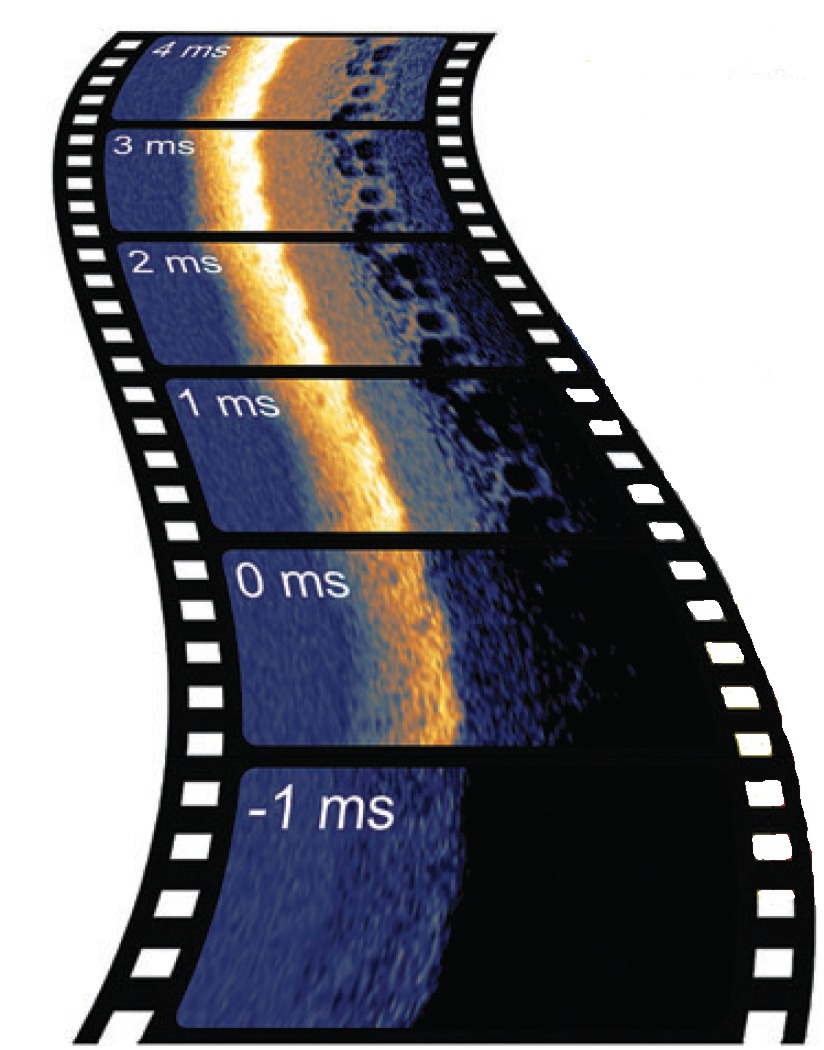 The underlying mechanism of the current-voltage hysteresis in a hybrid lead-halide perovskite
solar cell is still sketchy. We have developed a method based on Kelvin probe force microscopy that enables mapping charge
redistribution in an operating device upon a voltage- or light pulse with sub-millisecond resolution.
We observed the formation of a localized interfacial charge at the anode interface, which screened
most of the electric field in the cell. Our observation of a time-dependent ion concentration in the
perovskite layer suggests that iodide ions adsorbed and became neutralized at the hole-selective spiro-OMeTAD
electrode. Thus the formation and the release of interfacial charges is the dominating factor for
current-voltage hysteresis.
The underlying mechanism of the current-voltage hysteresis in a hybrid lead-halide perovskite
solar cell is still sketchy. We have developed a method based on Kelvin probe force microscopy that enables mapping charge
redistribution in an operating device upon a voltage- or light pulse with sub-millisecond resolution.
We observed the formation of a localized interfacial charge at the anode interface, which screened
most of the electric field in the cell. Our observation of a time-dependent ion concentration in the
perovskite layer suggests that iodide ions adsorbed and became neutralized at the hole-selective spiro-OMeTAD
electrode. Thus the formation and the release of interfacial charges is the dominating factor for
current-voltage hysteresis.
How drops start sliding over solid surfaces,
Nan Gao, Florian Geyer, Dominik W. Pilat, Sanghyuk Wooh, Doris Vollmer, Hans-Jürgen Butt, Rüdiger Berger✉,Nature Physics, 14, 191 - 196 (2018). doi: 10.1038/NPHYS4305
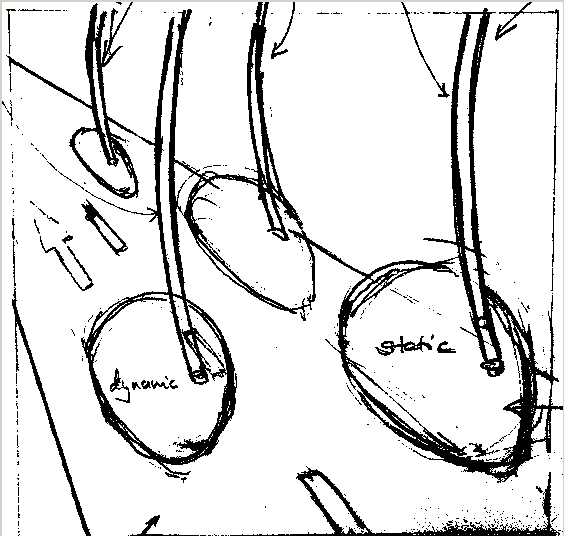 It has been known for more than 200 years that the maximum static friction force between
two solid surfaces is usually greater than the kinetic friction force. In contrast to solid-solid friction,
there is a lack of understanding of liquid-solid friction, i.e. the forces that impede the lateral motion of
a drop of liquid on a solid surface. Here, we report that the lateral adhesion force between a liquid drop
and a solid can be divided into a static and a kinetic regime. This striking analogy with solid-solid friction
is a generic phenomenon that holds for liquids of different polarities and surface tensions on smooth, rough
and structured surfaces.
It has been known for more than 200 years that the maximum static friction force between
two solid surfaces is usually greater than the kinetic friction force. In contrast to solid-solid friction,
there is a lack of understanding of liquid-solid friction, i.e. the forces that impede the lateral motion of
a drop of liquid on a solid surface. Here, we report that the lateral adhesion force between a liquid drop
and a solid can be divided into a static and a kinetic regime. This striking analogy with solid-solid friction
is a generic phenomenon that holds for liquids of different polarities and surface tensions on smooth, rough
and structured surfaces.
Response of public media:
Süddeutsche Zeitung,
Max Planck Society,
Inside Science,
Wissenschaft Aktuell
Adaptive Wetting - Adaptation in Wetting,
Hans-Jürgen Butt✉, Rüdiger Berger, Werner Steffen , Doris Vollmer, and Stefan A. L. Weber,Langmuir, 34, 11292 - 11304 (2018). 10.1021/acs.langmuir.8b01783
Young's modulus of plasma-polymerized allylamine films using micromechanical cantilever sensor and laser-based surface acoustic wave techniques,
Masaya Toda✉, Koji Miyake, Liqiang Chu, Marjan Zakerin, Renate Förch, Rüdiger Berger✉, Akiko N. Itakura✉,Plasma Process Polym., e1800083 (2018). doi: 10.1002/ppap.201800083
Genetically encoded lipid-polypeptide hybrid biomaterials that exhibit temperature-triggered hierarchical self-assembly,
Davoud Mozhdehi, Kelli M. Luginbuhl, Joseph R. Simon, Michael Dzuricky, Rüdiger Berger, H. Samet Varol, Fred C. Huang, Kristen L. Buehne, Nicholas R. Mayne, Isaac Weitzhandler, Mischa Bonn, Sapun H. Parekh and Ashutosh Chilkoti✉,Nature Chemistry, 10, 496 - 505 (2018). doi.org/10.1038/s41557-018-0005-z
Spatially resolved solid-state reduction of graphene oxide thin films,
Maria Morant-Minana✉, Jonas Heidler, Gunnar Glasser, Hao Lu, Rüdiger Berger, Nerea Gil-Gonzalez, Klaus Müllen, Dago de Leeuw, Kamal Asadi✉,Materials Horizons, 5, 1176-1184 (2018). doi: 10.1039/c8mh00895g
Calcium-Induced Molecular Rearrangement of Peptide Folds Enables Biomineralization of Vaterite Calcium Carbonate,
Hao Lu, Helmut Lutz, Steven J. Roeters, Matthew A. Hood, Arne Schäfer, Rafael Munoz-Espi, Rüdiger Berger, Mischa Bonn and Tobias Weidner✉,Journal of the American Chemical Society, 140, 2793 - 2796 (2018). doi: 10.1021/jacs.8b00281
Pico-thermogravimetric material properties analysis using a diamond cantilever beam,
Ioana Voiculescu✉, Meiyong Liao, Marjan Zakerin, Rüdiger Berger, Takahito Ono, Masaya Toda✉,Sensors and Actuators A, 271, 356-363 (2018). doi: 10.1016/j.sna.2018.01.004
Engineering Proteins at Interfaces: From Complementary Characterization to Material Surfaces with Designed Functions,
Svenja Morsbach, Grazia Gonella, Volker Mailänder, Seraphine Wegner, Si Wu, Tobias Weidner, Rüdiger Berger, Kaloian Koynov, Doris Vollmer, Noemi Encinas, Seah Ling Kuan, Tanja Weil, Mischa Bonn, Hans-Jürgen Butt and Katharina Landfester✉,Angewandte Chemie, 57, 12626 - 12648 (2018).
Publications in 2017
Thiolated Lysine-Leucine Peptides Self-Assemble into Biosilica Nucleation Pits on Gold Surfaces,
Hao Lu, Yeneneh Yimer, Rüdiger Berger, Mischa Bonn, Jim Pfaendtner, Tobias Weidner✉Advanced Materials Interfaces, 4, 1700399 (2017). doi: 10.1002/admi.201700399
Thermal Characterization of Dynamic Silicon Cantilever Array Sensors by Digital Holographic Microscopy,
Marjan Zakerin, Antonin Novak, Masaya Toda, Yves Emery, Filipe Natalio, Hans-Jürgen Butt, Rüdiger Berger✉Sensors, 17, 1191 (2017). doi: 10.3390/s17061191
Photoswitching of glass transition temperatures of azobenzene-containing polymers induces reversible solid-to-liquid transitions,
Hongwei Zhou, Changguo Xue, Philipp Weis, Yasuhito Suzuki, Shilin Huang, Kaloian Koynov, Günter K. Auernhammer, Rüdiger Berger, Hans-Jürgen Butt and Si Wu✉,Nature Chemistry 9, 145 - 151 (2017). doi: 10.1038/nchem.2625
Energy Dissipation of Moving Drops on Superhydrophobic and Superoleophobic Surfaces,
Hans-Jürgen Butt✉, Nan Gao, Periklis Papadopoulos, Werner Steffen, Michael Kappl, Rüdiger Berger,Langmuir 33, 107 - 116 (2017). doi 10.1021/acs.langmuir.6b03792
Reliable Work Function Determination of Multicomponent Surfaces and Interfaces: The Role of Electrostatic Potentials in Ultraviolet Photoelectron Spectroscopy,
Thorsten Schultz, Thomas Lenz, Naresh Kotadiya, Georg Heimel, Gunnar Glasser, Rüdiger Berger, Paul Blom, Patrick Amsalem, Dago de Leeuw, Norbert Koch✉,Advanced Materials Interfaces 4, 1700324 (2017). 10.1002/admi.201700324
Publications in 2016
Local Time-Dependent Charging in a Perovskite Solar Cell,
Victor Bergmann, Yunlong Guo, Hideyuki Tanaka, Ilka Hermes, Dan Li, Alexander Klasen, Simon Bretschneider, Eiichi Nakamura, Rüdiger Berger✉, Stefan Weber✉, ACS Applied Materials & Interfaces, 8 (30), 19402 - 19409 (2016). doi: 10.1021/acsami.6b04104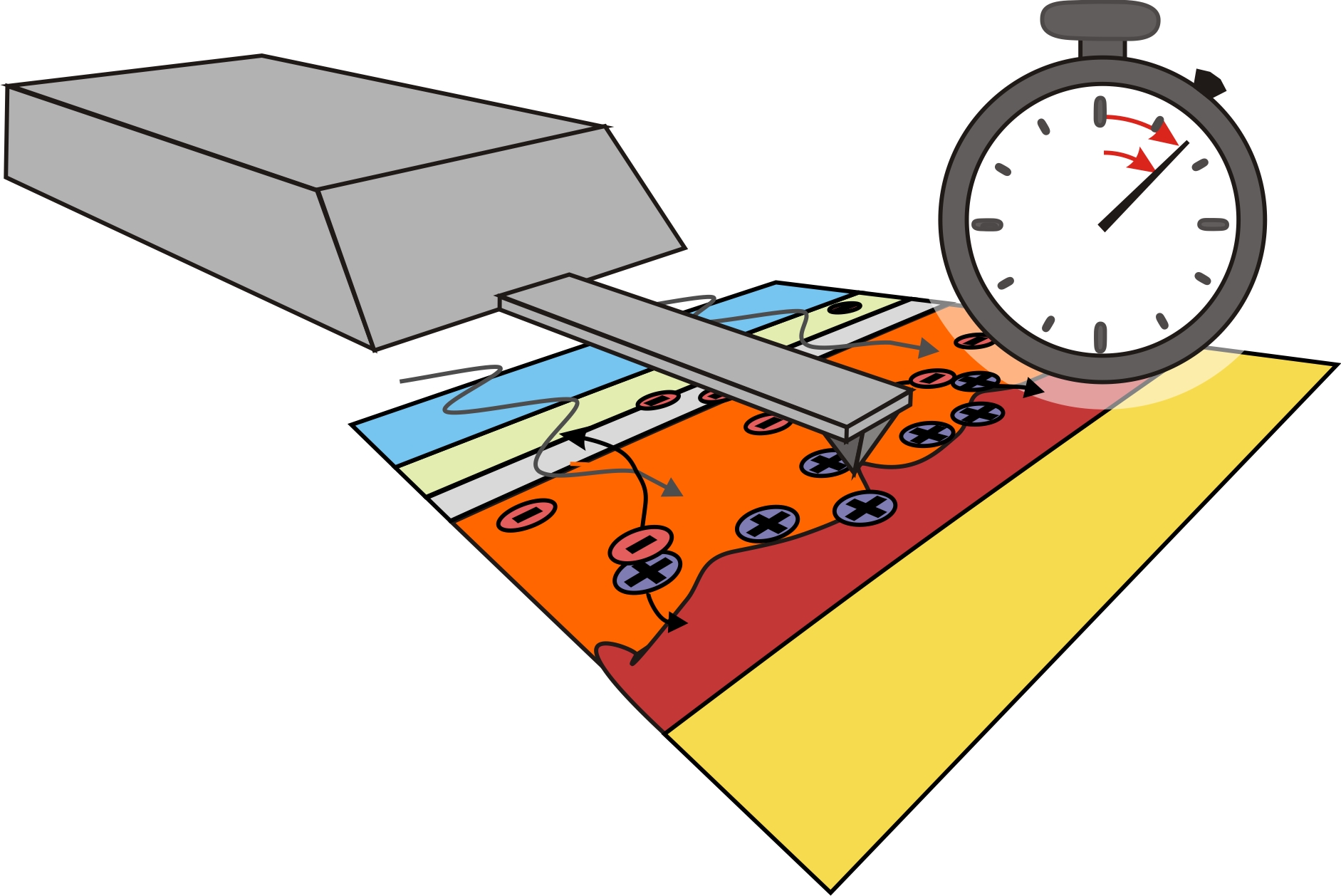 Efficient charge extraction within solar cells explicitly depends on the optimization of
the internal interfaces. In the case of perovskite solar cells, slow processes
happening on timescales of seconds cause hysteresis in the current-voltage characteristics. Here, we localized
and investigated these slow processes with frequency modulation Kelvin probe force microscopy (FM-KPFM) on cross
sections of planar methylammonium lead iodide (MAPI) perovskite solar cells. FM-KPFM can map the charge density
distribution and its dynamics at internal interfaces. Upon illumination, space charge layers were forming at the
interfaces to the MAPI layer within several seconds. We observed distinct differences in the charging dynamics at
interfaces of the MAPI to adjacent layers. Our results attest that more than one process is involved in
hysteresis.
Efficient charge extraction within solar cells explicitly depends on the optimization of
the internal interfaces. In the case of perovskite solar cells, slow processes
happening on timescales of seconds cause hysteresis in the current-voltage characteristics. Here, we localized
and investigated these slow processes with frequency modulation Kelvin probe force microscopy (FM-KPFM) on cross
sections of planar methylammonium lead iodide (MAPI) perovskite solar cells. FM-KPFM can map the charge density
distribution and its dynamics at internal interfaces. Upon illumination, space charge layers were forming at the
interfaces to the MAPI layer within several seconds. We observed distinct differences in the charging dynamics at
interfaces of the MAPI to adjacent layers. Our results attest that more than one process is involved in
hysteresis.
Stability of a Split-RNA-Aptamer, Capable of Streptomycin Binding,
Thomas A. Nick, Tiago E. de Oliveira, Dominik W. Pilat, Felix Spenkuch, Hans-Jürgen Butt, Mark Helm✉, Paulo A. Netz✉, and Rüdiger Berger✉, Journal of Physical Chemistry Part B, 120 (27), 6479 - 6489 (2016). doi: 10.1021/acs.jpcb.6b02440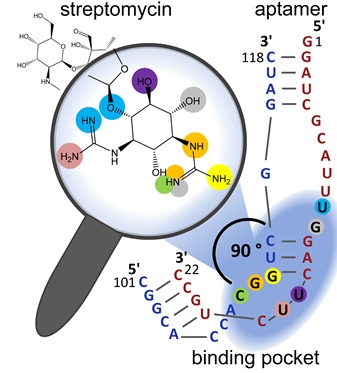 In this paper we investigated the stability of an aptamer, which is formed by two RNA-strands
and binds the antibiotic streptomycin. Molecular dynamics simulations in aqueous solution confirmed the geometry and
the pattern of hydrogen bond interactions that was derived from the crystal-structure. The result of umbrella
sampling simulations indicated a favored streptomycin-binding. Experimentally, the increase in oligonucleotide
stability upon binding of streptomycin was probed by single-molecule force spectroscopy. Rate dependent force
spectroscopy measurements revealed a decrease in the natural off-rate for the aptamer-streptomycin complex
compared to the aptamer having an empty binding pocket. The simulated binding pattern and the experimental results
led to the conclusion that hydrogen-bonds between both RNA strands mainly contribute to the decrease in natural-off
rate.
In this paper we investigated the stability of an aptamer, which is formed by two RNA-strands
and binds the antibiotic streptomycin. Molecular dynamics simulations in aqueous solution confirmed the geometry and
the pattern of hydrogen bond interactions that was derived from the crystal-structure. The result of umbrella
sampling simulations indicated a favored streptomycin-binding. Experimentally, the increase in oligonucleotide
stability upon binding of streptomycin was probed by single-molecule force spectroscopy. Rate dependent force
spectroscopy measurements revealed a decrease in the natural off-rate for the aptamer-streptomycin complex
compared to the aptamer having an empty binding pocket. The simulated binding pattern and the experimental results
led to the conclusion that hydrogen-bonds between both RNA strands mainly contribute to the decrease in natural-off
rate.
Controlled Mutual Diffusion between Fullerene and Conjugated Polymer Nanopillars in Ordered Heterojunction Solar Cells,
Jongkuk Ko, Jiyun Song, Hyunsik Yoon, Taeyong Kim, Changhee Lee, Rüdiger Berger✉ and Kookheon Char✉, Advanced Materials Interfaces, 1600264 (2016). doi: 10.1002/admi.201600264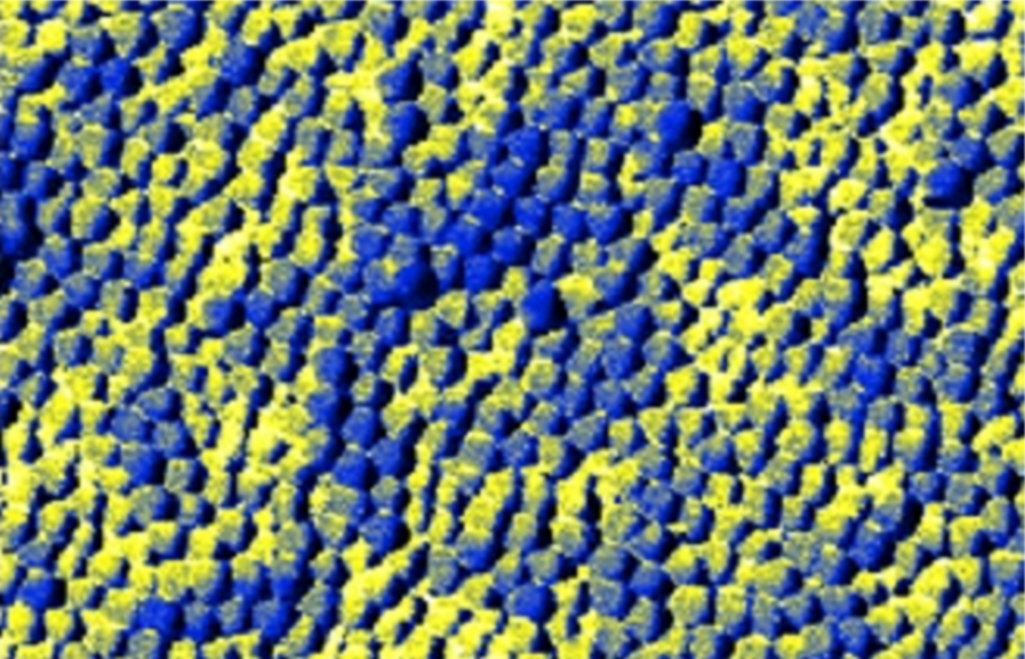 This paper descibes a new approach to control the nanomorphology of organic solar cells
in a predictable, controllable, and easily-scalable way. In particular, the nanomorphology was studied in nanostructural and
electrical properties of the pillar samples using scanning probe microscopy. Conductive scanning force microscopy
in quantitative imaging mode, applied to the pillar-based samples for the first time, allows us to establish a
clear relationship between nanomorphology, nanoelectrical property, and macroscale device performance.
This paper descibes a new approach to control the nanomorphology of organic solar cells
in a predictable, controllable, and easily-scalable way. In particular, the nanomorphology was studied in nanostructural and
electrical properties of the pillar samples using scanning probe microscopy. Conductive scanning force microscopy
in quantitative imaging mode, applied to the pillar-based samples for the first time, allows us to establish a
clear relationship between nanomorphology, nanoelectrical property, and macroscale device performance.
Surface forces between colloidal particles at high hydrostatic pressure,
D. W. Pilat, B. Pouligny, A. Best, T. A. Nick, R. Berger✉, and H.-J. Butt,Physical Review E, 022608 (2016). doi: 10.1103/PhysRevE.93.022608
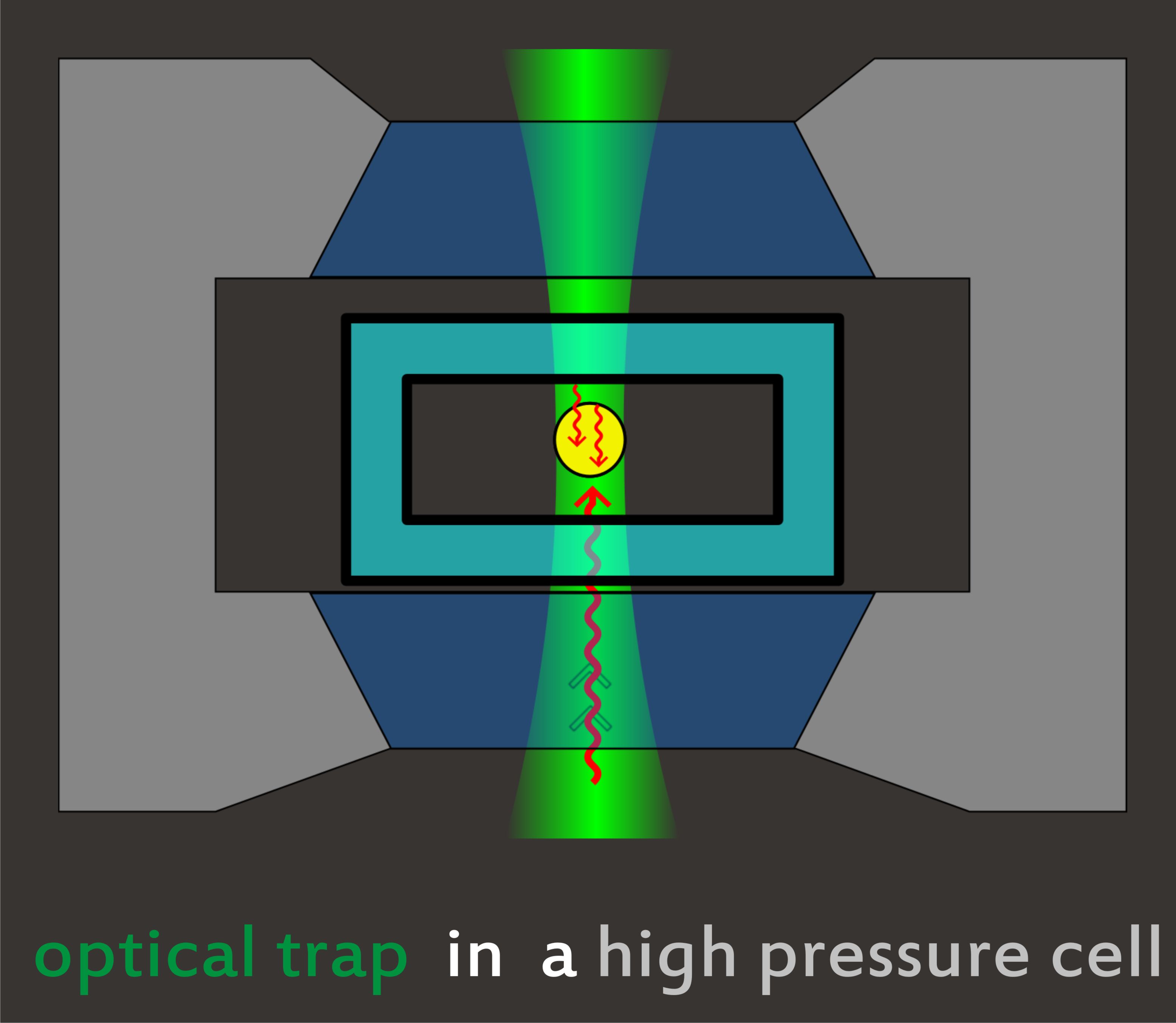 It was recently suggested that the electrostatic double-layer force between colloidal particles
might weaken at high hydrostatic pressure encountered, for example, in deep seas or during oil recovery. We have addressed
this issue by means of a specially designed optical trapping setup that allowed us to explore the interaction of a micrometer-sized
glass bead and a solid glass wall in water at hydrostatic pressures of up to 1 kbar. The setup allowed us to measure the distance
between bead and wall with a subnanometer resolution. We have determined the Debye lengths in water for salt concentrations
of 0.1 and 1 mM. We found that in the pressure range from 1 bar to 1 kbar the maximum variation of the Debye lengths was
smaller than 1 nm for both salt concentrations. Furthermore, the magnitude of the zeta potentials of the glass surfaces in water showed
no dependency on pressure.
It was recently suggested that the electrostatic double-layer force between colloidal particles
might weaken at high hydrostatic pressure encountered, for example, in deep seas or during oil recovery. We have addressed
this issue by means of a specially designed optical trapping setup that allowed us to explore the interaction of a micrometer-sized
glass bead and a solid glass wall in water at hydrostatic pressures of up to 1 kbar. The setup allowed us to measure the distance
between bead and wall with a subnanometer resolution. We have determined the Debye lengths in water for salt concentrations
of 0.1 and 1 mM. We found that in the pressure range from 1 bar to 1 kbar the maximum variation of the Debye lengths was
smaller than 1 nm for both salt concentrations. Furthermore, the magnitude of the zeta potentials of the glass surfaces in water showed
no dependency on pressure.
Humidity-induced grain boundaries in MAPbI3 perovskite films,
Dan Li, Simon A. Bretschneider, Victor W. Bergmann, Ilka M. Hermes, Julian Mars, Alexander Klasen, Wolfgang Tremel, Markus Mezger, Hans-Jürgen Butt, Stefan A. L. Weber, Rüdiger Berger✉,Journal of Physical Chemistry C, 120, 6363 - 6368 (2016). doi: 10.1021/acs.jpcc.6b00335
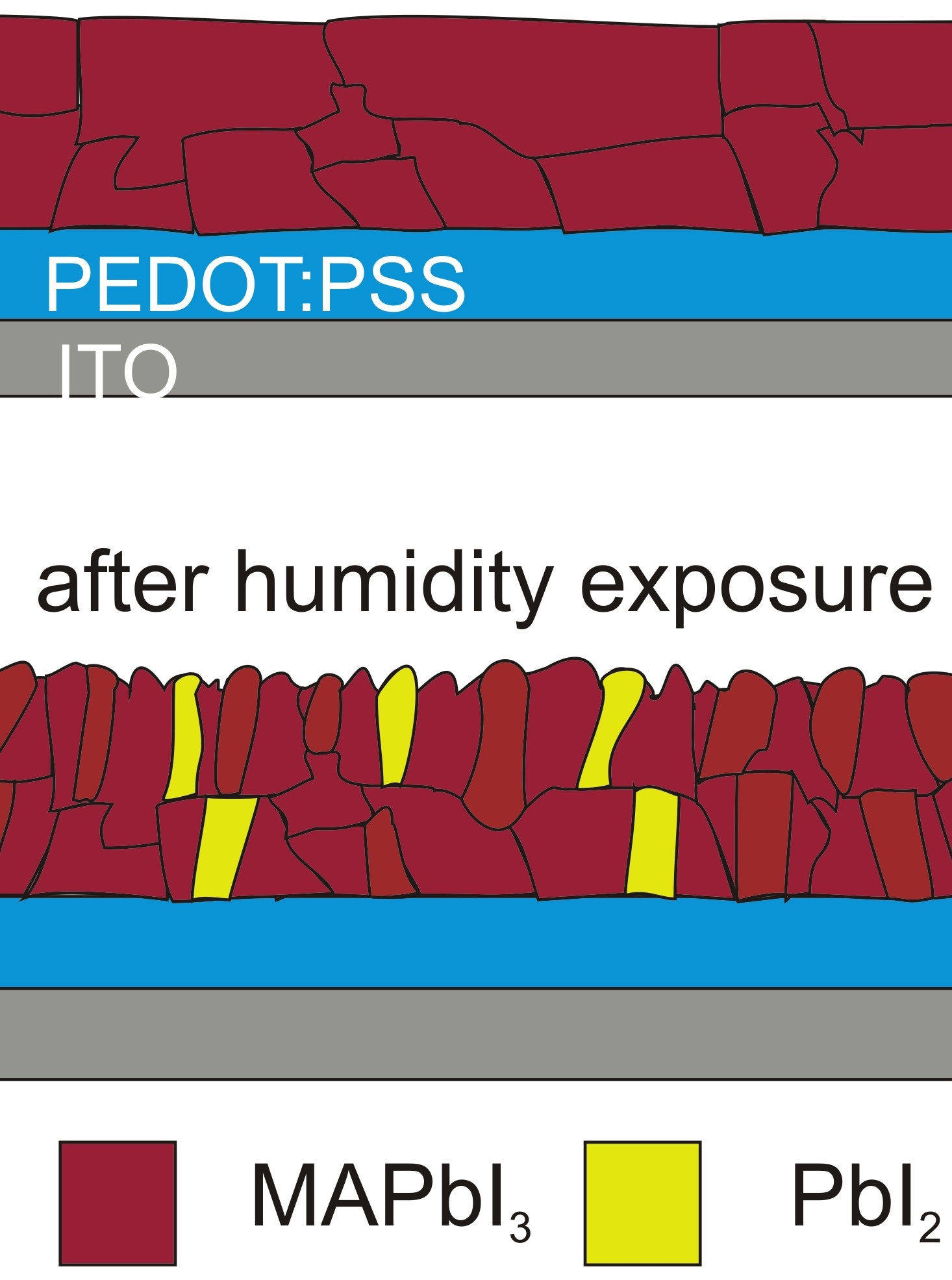 Methylammonium halide perovskites (MAPbI3) are sensitive to humidity environments. We performed
in-situ scanning force microscope and in-situ X-ray diffraction measurements on MAPbI3 films to track changes in the film morphology
and crystal structure upon repeated exposure to a high relative humidity of 80%. The appearance of mono-hydrate diffraction peaks
(MAPbI3 H2O) coincided with the appearance of additional grain boundaries outlined as black lines in the left handed sketch. Prolonged
exposure to humidity induced more steps in the MAPbI3 films and the peak intensities of the mono-hydrated phase increased.
The mono hydrated phase was not stable under dry atmosphere and could be reversed to MAPbI3. However, the humidity induced grain boundaries
persisted. The presence of these additional grain boundaries is most likely the reason for an increase in hysteresis in JV behavior.
Methylammonium halide perovskites (MAPbI3) are sensitive to humidity environments. We performed
in-situ scanning force microscope and in-situ X-ray diffraction measurements on MAPbI3 films to track changes in the film morphology
and crystal structure upon repeated exposure to a high relative humidity of 80%. The appearance of mono-hydrate diffraction peaks
(MAPbI3 H2O) coincided with the appearance of additional grain boundaries outlined as black lines in the left handed sketch. Prolonged
exposure to humidity induced more steps in the MAPbI3 films and the peak intensities of the mono-hydrated phase increased.
The mono hydrated phase was not stable under dry atmosphere and could be reversed to MAPbI3. However, the humidity induced grain boundaries
persisted. The presence of these additional grain boundaries is most likely the reason for an increase in hysteresis in JV behavior.
Nanoscale heterogeniety and workfunction variations in ZnO thin films,
Anirudh Sharma, Maria Untch, Jamie S. Quinton, Rüdiger Berger✉, Gunther Andersson, David A. Lewis✉,Applied Surface Science, 363, 516 - 521 (2016). doi: 10.1016/j.apsusc.2015.11.190
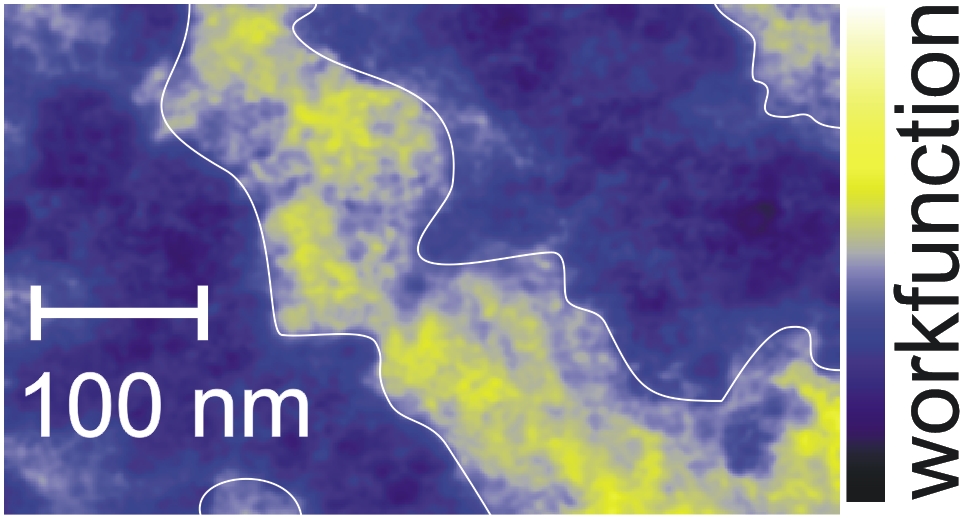 Nano-roughened, sol-gel derived polycrystalline ZnO thin films prepared by a thermal ramping procedure
were found to exhibit different work function values on a sub-micrometer scale. By Kelvin probe force microscopy (KPFM)
two distinct nanoscale regions with work function differing by over 0.1 eV were detected which did not coincide with
the nano-roughened surface topography. Such heterogeneity in the electronic properties of materials in thin film devices
can significantly influence the interfacial charge transport across materials.
Nano-roughened, sol-gel derived polycrystalline ZnO thin films prepared by a thermal ramping procedure
were found to exhibit different work function values on a sub-micrometer scale. By Kelvin probe force microscopy (KPFM)
two distinct nanoscale regions with work function differing by over 0.1 eV were detected which did not coincide with
the nano-roughened surface topography. Such heterogeneity in the electronic properties of materials in thin film devices
can significantly influence the interfacial charge transport across materials.
Influence of the mixed organic cation ratio in lead iodide based perovskite on the performance of solar cells,
Manuel Salado, Laura Calio, Rüdiger Berger, Samrana Kazim✉ and Shahzada Ahmad✉,Physical Chemistry Chemical Physics 18, 27148 - 27157 (2016). doi: 10.1039/C6CP03851D
Ferroelastic Fingerprints in Methylammonium Lead Iodide Perovskite,
Ilka Hermes, Simon Bretschneider, Victor Bergmann, Dan Li, Alexander Klasen, Julian Mars, Wolfgang Tremel, Frederik Laquai, Hans-Jürgen Butt, Markus Mezger, Rüdiger Berger, Brian Rodriguez, Stefan Weber✉,Journal of Physical Chemistry C 10, 5724 - 5731 (2016). doi 10.1021/acs.jpcc.5b11469
Bottom-up Fabrication of Nanopatterned Polymers on DNA Origami by In-situ Atom Transfer Radical Polymerization,
Yu Tokura, Yanyan Jiang, Alexander Welle, Martina H. Stenzel, Katarzyna Krzemien, Jens Michaelis, Rüdiger Berger, Christopher Barner-Kowollik, Yuzhou Wu and Tanja Weil✉,Angewandte Chemie 128, 5786 - 5791 (2016). doi 10.1002/ange.201511761
Semifluorinated Alkanes at the Air-Water Interface: Tailoring Structure and Rheology at the Molecular Scale,
Antigoni Theodoratou, Ulrich Jonas, Benoit Loppinet, Thomas Geue, Rene Stangenberg, Rabea Keller, Dan Li, Rüdiger Berger, Jan Vermant, Dimitris Vlassopoulos✉,Langmuir 32, 3139 - 3151 (2016). doi 10.1021/acs.langmuir.5b04744